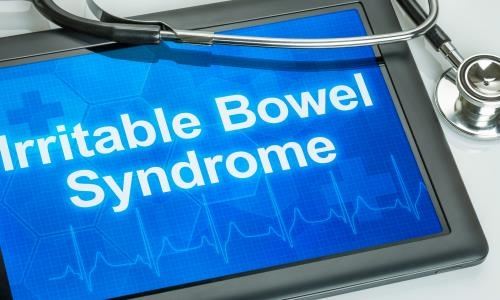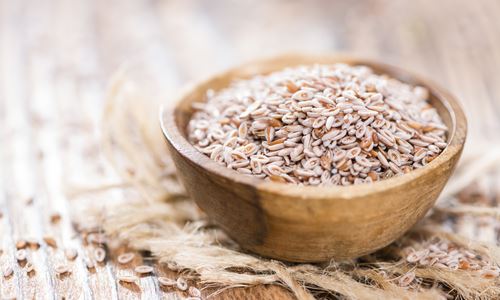Welcome to our Clinical Library
Here you will find a selection of clinical research papers and summaries related to gluten-related disorders. Use the topic options below to select your specific area of interest, or search by author and date.
Clinical Library
58
Duodenal biopsies for the diagnosis of coeliac disease: are we adhering to current guidance?
Coeliac disease (CD) can present with a wide range of non-specific abdominal symptoms, alongside a number of atypical symptoms. As a result, it is important to ensure that when CD is a considered as a potential diagnosis, patients are adequately investigated to avoid missed or delayed diagnosis.
>>Read more<<
>>Read more<<

Follow-up of patients with functional bowel symptoms treated with a low FODMAP diet
This retrospective, cross-sectional study aimed to investigate patient-reported long-term effects of the LFD, long-term adherence and dietary impact on disease course in patients with IBS and patients with IBD and co-existing IBS treated with the LFD.
>>Read more<<
>>Read more<<

Pre-endoscopy Point of Care Test (Simtomax®- IgA/IgG-Deamidated Gliadin Peptide) for Coeliac Disease in Iron Deficiency: Diagnostic Accuracy and a Cost-Saving Economic Model.
Existing data has shown 2.6-8.7% of patients attending endoscopy with anaemia are subsequently diagnosed with CD. However, availability and utilisation of coeliac serology prior to endoscopy appears to be variable. If serology is unavailable, this commits the clinician to take duodenal biopsies; an expensive way of detecting cases. The aim of this study was to evaluate the role of utilising a pre-endoscopy Point of Care Test (POCT) for CD in iron-deficiency in a cost-saving model.
>>Read more<<
>>Read more<<

Early recognition of coeliac disease through community pharmacies: a proof of concept study
The aim of the paper is to provide a proof of concept study, which determines the service feasibility and acceptability of providing coeliac screening in a number of community pharmacies to help improve diagnosis.
>>Read more<<
>>Read more<<

Is there a relationship between gluten sensitivity and postural tachycardia syndrome?
Alongside the more classical presentation of coeliac disease, patients with this condition frequently report a range of extraintestinal symptoms, including those that may be related to the autonomic nervous system, including palpitations, dizziness and presyncope (1-3).
>>Read more<<
>>Read more<<

New NICE Quality Standard on Coeliac Disease supports the provision of gluten-free food on prescription
The National Institute of Health and Care Excellence (NICE) has launched its first Quality Standard on coeliac disease, aiming to drive measurable improvements in the diagnosis, support and health of people with coeliac disease. It also identifies the need to address health inequalities.
>>Read more<<
>>Read more<<

Long- term response to gluten-free diet as evidence for non-celiac wheat sensitivity in one third of patients with diarrhoea- dominant and mixed-type irritable bowel syndrome
The aim of the study was to analyse if HLA-DQ2 and DQ8 are suitable markers for the diagnosis of wheat sensitivity (WS) and to evaluate the long-term clinical response to a GFD in a defined cohort of patients with IBS-D and IBS-M.
>>Read more<<
>>Read more<<

Randomised clinical trial: the efficacy of gut-directed hypnotherapy is similar to that of the low FODMAP diet for the treatment of irritable bowel syndrome
The aims of the study where to perform a randomised clinical trial in patients with IBS, naïve to dietary or psychological therapies, to compare the effect of gut-directed hypnotherapy with the low FODMAP diet, alone or in combination on symptoms and psychological health over both a short (6 week) and long term (6 month) period.
>>Read more<<
>>Read more<<

Using best practice to create a pathway to improve management of irritable bowel syndrome: aiming for timely diagnosis, effective treatment and equitable care
This pilot project outlines the methods employed in one CCG to successfully develop a cost-effective IBS pathway with reduced secondary care involvement and improvement in patient care.
>>Read more<<
>>Read more<<

Intestinal cell damage and systemic immune activation in individuals reporting sensitivity to wheat in the absence of coeliac disease
The results of this study demonstrate the presence of objective markers of systemic immune activation and correlating serum markers of gut epithelial cell damage in individuals who report sensitivity to wheat, rye and barley in the absence of CD.
>> Read more... <<<
>> Read more... <<<

Efficacy of a gluten-free diet in subjects with IBS-D unaware of their HLA-DQ2/8 genotype
Aziz, A, Trott N, Briggs R, et al
Clin Gastroenterol Hepatol.
IBS-D accounts for almost one third of IBS patients and is the predominant subtype of IBS encountered in clinical practice. Research suggests that 84% of patients with IBS believe that food triggers their gastrointestinal symptoms and of these, gluten-based products are cited by approximately 1 in 4 patients as a common trigger. These observations have given rise to the clinical entity known as ‘non-coeliac gluten sensitivity’ (NCGS). However, NCGS remains a controversial condition due to the existence of co-existing non-gluten components (including FODMAPs) that have also been demonstrated to induce IBS symptoms. The purpose of this prospective study was to evaluate the clinical response to a gluten free diet (GFD) in a cohort of patients with IBS-D blinded to their HLA-DQ status. The long-term benefit and sustainability of a gluten free diet was also assessed. The study was conducted at the Royal Hallamshire Hospital in Sheffield between Sept 2012 and July 2015. Patients attending the gastroenterology out-patient clinic who fulfilled the Rome II criteria for IBS-D were eligible for inclusion. Coeliac disease was excluded based on negative serology and normal duodenal biopsy. Individuals with self-reported gluten sensitivity; those already on a GFD; and those with other medical conditions known to mimic IBS-D were also excluded. Seventy eight participants were selected as eligible to take part in the study, of these 48 patients agreed to enrol (24 HLA-DQ2/8+ve and 24 HLA- DQ2/8-ve). Subjects were referred to 1 of 2 senior dietitians who provided uniform information on how to undertake a GFD. Subjects were also given validated questionnaires to self-complete the day before commencing a GFD and during the GFD period, these included the IBS Symptom Severity Score (IBS-SSS), Hospital Anxiety and Depression Scale (HADS), Fatigue Impact Score (FIS), and Short-form 36 (SF-36) quality of life questionnaire. Seven subjects dropped out of the study (4 did not attend their initial dietitian appointment; 1 became pregnant; 1 started an additional diet; and 1 felt the GFD was too expensive). Those subjects remaining (21 HLA-DQ –ve; 20 HLA DQ +ve) were instructed to follow a GFD for 6 weeks, after which they returned for a follow-up appointment with the dietitians and returned their questionnaires. Dietary adherence was evaluated using a simple, validated tool. Patients were also asked if they intended to continue with a GFD for the foreseeable future. For those that answered yes, a follow-up dietitian appointment was arranged for approximately 18 months time. Importantly, both dietitians and patients were blinded to the fact that HLA-DQ2/8 status was being used as a comparative factor within the study. Following the 6-week GFD, a reduction of IBS-SSS of =50 points (indicating clinical benefit) was seen in 71% of patients, there was no difference between HLA-DQ groups. A significant symptom reduction was seen as early as week 2 and this continued to drop between each interval at week 4 and week 6. The greatest improvements were seen in those who had the severest IBS scores at baseline. In terms of IBS subscales, a significant mean reduction in abdominal pain, pain frequency, stool dissatisfaction and life interferences was observed in both HLA-DQ subgroups, with no difference between groups. However HLA-DQDQ2/8-ve subjects showed a greater reduction in abdominal distension compared with HLA-DQ2/8+ve subjects (p=0.04). A significant improvement in HADS, FIS and SF-36 quality of life was also observed following a GFD, seen across both groups. However HLA-DQ2/8+ve patients experienced a significantly greater improvement in depression (p=0.02) and vitality (p=0.03) compared with the HLA-DQ2/8-ve group. At the end of the 6-week intervention, 72% of IBS-SS responders planned to continue to follow a GFD for the foreseeable future (11 HLA-DQ2/8+ve and 10 HLA-DQ2/8-ve). When these patients were contacted on average 18 months later, all were still following a GFD with a good level of adherence and reported ongoing symptom improvement without any alterations in body mass index or biochemical status (compared to baseline). The results of this study demonstrate that a dietitian-led GFD should be considered as a therapeutic option for the management of patients with IBS-D who are previously naïve to the effects of gluten. The strengths of this study lie in it’s rigorously defined cohort, in which CD was excluded and patients and dietitians were blinded to the fact that HLA-DQ2/8 status was being used as a comparative factor. This study also demonstrates a real-life situation in which patients were provided with a single dietetic consultation and then left to follow the GFD themselves, rather than being provided with all meals in a heavily controlled research environment. The limitations of the study include the placebo-effect of undertaking a dietary trial, however this is unlikely to account fully for the 71% response rate observed, particularly in view of the fact that well-being was maintained at 18 months. The authors of this study speculate that the patho-physiological mechanisms resulting in symptom reduction for IBS-D patients treated with a GFD may differ according to HLA-DQ status, and this is worthy of further mechanistic exploration.
>>Click to read abstract
Clin Gastroenterol Hepatol.
IBS-D accounts for almost one third of IBS patients and is the predominant subtype of IBS encountered in clinical practice. Research suggests that 84% of patients with IBS believe that food triggers their gastrointestinal symptoms and of these, gluten-based products are cited by approximately 1 in 4 patients as a common trigger. These observations have given rise to the clinical entity known as ‘non-coeliac gluten sensitivity’ (NCGS). However, NCGS remains a controversial condition due to the existence of co-existing non-gluten components (including FODMAPs) that have also been demonstrated to induce IBS symptoms. The purpose of this prospective study was to evaluate the clinical response to a gluten free diet (GFD) in a cohort of patients with IBS-D blinded to their HLA-DQ status. The long-term benefit and sustainability of a gluten free diet was also assessed. The study was conducted at the Royal Hallamshire Hospital in Sheffield between Sept 2012 and July 2015. Patients attending the gastroenterology out-patient clinic who fulfilled the Rome II criteria for IBS-D were eligible for inclusion. Coeliac disease was excluded based on negative serology and normal duodenal biopsy. Individuals with self-reported gluten sensitivity; those already on a GFD; and those with other medical conditions known to mimic IBS-D were also excluded. Seventy eight participants were selected as eligible to take part in the study, of these 48 patients agreed to enrol (24 HLA-DQ2/8+ve and 24 HLA- DQ2/8-ve). Subjects were referred to 1 of 2 senior dietitians who provided uniform information on how to undertake a GFD. Subjects were also given validated questionnaires to self-complete the day before commencing a GFD and during the GFD period, these included the IBS Symptom Severity Score (IBS-SSS), Hospital Anxiety and Depression Scale (HADS), Fatigue Impact Score (FIS), and Short-form 36 (SF-36) quality of life questionnaire. Seven subjects dropped out of the study (4 did not attend their initial dietitian appointment; 1 became pregnant; 1 started an additional diet; and 1 felt the GFD was too expensive). Those subjects remaining (21 HLA-DQ –ve; 20 HLA DQ +ve) were instructed to follow a GFD for 6 weeks, after which they returned for a follow-up appointment with the dietitians and returned their questionnaires. Dietary adherence was evaluated using a simple, validated tool. Patients were also asked if they intended to continue with a GFD for the foreseeable future. For those that answered yes, a follow-up dietitian appointment was arranged for approximately 18 months time. Importantly, both dietitians and patients were blinded to the fact that HLA-DQ2/8 status was being used as a comparative factor within the study. Following the 6-week GFD, a reduction of IBS-SSS of =50 points (indicating clinical benefit) was seen in 71% of patients, there was no difference between HLA-DQ groups. A significant symptom reduction was seen as early as week 2 and this continued to drop between each interval at week 4 and week 6. The greatest improvements were seen in those who had the severest IBS scores at baseline. In terms of IBS subscales, a significant mean reduction in abdominal pain, pain frequency, stool dissatisfaction and life interferences was observed in both HLA-DQ subgroups, with no difference between groups. However HLA-DQDQ2/8-ve subjects showed a greater reduction in abdominal distension compared with HLA-DQ2/8+ve subjects (p=0.04). A significant improvement in HADS, FIS and SF-36 quality of life was also observed following a GFD, seen across both groups. However HLA-DQ2/8+ve patients experienced a significantly greater improvement in depression (p=0.02) and vitality (p=0.03) compared with the HLA-DQ2/8-ve group. At the end of the 6-week intervention, 72% of IBS-SS responders planned to continue to follow a GFD for the foreseeable future (11 HLA-DQ2/8+ve and 10 HLA-DQ2/8-ve). When these patients were contacted on average 18 months later, all were still following a GFD with a good level of adherence and reported ongoing symptom improvement without any alterations in body mass index or biochemical status (compared to baseline). The results of this study demonstrate that a dietitian-led GFD should be considered as a therapeutic option for the management of patients with IBS-D who are previously naïve to the effects of gluten. The strengths of this study lie in it’s rigorously defined cohort, in which CD was excluded and patients and dietitians were blinded to the fact that HLA-DQ2/8 status was being used as a comparative factor. This study also demonstrates a real-life situation in which patients were provided with a single dietetic consultation and then left to follow the GFD themselves, rather than being provided with all meals in a heavily controlled research environment. The limitations of the study include the placebo-effect of undertaking a dietary trial, however this is unlikely to account fully for the 71% response rate observed, particularly in view of the fact that well-being was maintained at 18 months. The authors of this study speculate that the patho-physiological mechanisms resulting in symptom reduction for IBS-D patients treated with a GFD may differ according to HLA-DQ status, and this is worthy of further mechanistic exploration.
>>Click to read abstract

Anaemia in pediatric celiac disease: association with clinical and histological features and response to a gluten-free diet
Coeliac disease (CD) is one of the most common, lifelong gastrointestinal disorders in children. One of the most common manifestations of CD in children is iron-deficiency anaemia. Even mild or subclinical anaemia can be detrimental to health since it predisposes to poor cognitive and psychomotor development and to impaired immune defence. This retrospective study compared a variety of clinical, histological, serological and laboratory findings and dietary response between children presenting with and those without anaemia at CD diagnosis.
Serological findings were collected from the medical records of 455 children with biopsy-proven CD diagnosed at the Department of Paediatric Gastroenterology, Tampere University Hospital, Finland from the year 2000 onwards. Children were divided into those with and those without anaemia at the time of CD diagnosis, and all study variables were compared between groups, including:
Of the 455 children studies, 82 (18%) were found to have anaemia at diagnosis. Children with anaemia were significantly older and had fewer family members with CD compared to non-anaemic patients. The main clinical presentation at diagnosis was more often extraintestinal. Of specific gastrointestinal symptoms, the anaemic patients suffered less from vomiting, and there was also a non-significant trend towards more constipation and less diarrhoea. The median values for both tTG and EmA antibodies were higher in the anaemia group at diagnosis. Anaemic children also had more severe small bowel mucosal damage, with a higher proportion of total villous atrophy.
Children in the anaemia group showed significantly poorer adherence to the GFD at follow-up, however, in all cases there were only occasional lapses and none reported unrestricted gluten consumption. After a median of 12 months on a GFD, coeliac autoantibody and haemoglobin levels were significantly improved in both groups, but the anaemia group still yielded significantly lower median haemoglobin levels than the non-anaemic group. Four subjects suffered from persistent anaemia despite being on a strict GFD and demonstrating good clinical and serological response. Twenty-five anaemic children initiated oral iron supplementation after diagnosis (including 3 of the 4 with persistent anaemia). Overall, clinical response to the GFD (as measured by disappearance of symptoms, marked decrease of CD autoantibodies and improvement of growth abnormalities and abnormal laboratory values) was seen in 94.3% of anaemic children and 96.6% of non-anaemic children.
The main finding in this study was that children with anaemia at the time of CD diagnosis had more severe disease in terms of serology and small bowel histology, compared to those without anaemia at diagnosis. In addition, the anaemic children showed incomplete recovery of haemoglobin values, even after a median of 1 year on a GFD. This finding correlates with similar work published within adult coeliac populations1. It seems logical that severe enteropathy should predispose to iron deficiency due to the reduced absorptive surface of the intestine, although this was not supported by a correlating higher incidence of diarrhoea or poorer growth within the anaemic group, as might be expected. It seems possible that anaemia might not simply be an outcome of CD but perhaps also an active player in CD pathogenesis. In a previous study, Matysiak-Budnik et al2 reported that gluten may enter the body via enterocyte transferrin receptors, whose expression is increased during iron deficiency. As a result, anaemia could further promote gluten exposure, leading to a self-perpetuating pathogenic loop.
The authors of this study concluded that the presence of anaemia at CD diagnosis is associated with more advanced clinical and histological presentation. Therefore, early detection of anaemia in this patient group is important to prevent possible permanent complications related to advanced CD. Clinicians should also be aware that the recovery of anaemic patients may take longer than expected, despite a strict GFD and thus special emphasis should be placed on the follow-up of this patient group.
References
Serological findings were collected from the medical records of 455 children with biopsy-proven CD diagnosed at the Department of Paediatric Gastroenterology, Tampere University Hospital, Finland from the year 2000 onwards. Children were divided into those with and those without anaemia at the time of CD diagnosis, and all study variables were compared between groups, including:
- Demographics
- Anthropometrics
- Co-morbidities
- Family history of CD
- Type of clinical presentation (gastrointestinal/ extraintestinal/ screen detected)
- Severity of presentation
Of the 455 children studies, 82 (18%) were found to have anaemia at diagnosis. Children with anaemia were significantly older and had fewer family members with CD compared to non-anaemic patients. The main clinical presentation at diagnosis was more often extraintestinal. Of specific gastrointestinal symptoms, the anaemic patients suffered less from vomiting, and there was also a non-significant trend towards more constipation and less diarrhoea. The median values for both tTG and EmA antibodies were higher in the anaemia group at diagnosis. Anaemic children also had more severe small bowel mucosal damage, with a higher proportion of total villous atrophy.
Children in the anaemia group showed significantly poorer adherence to the GFD at follow-up, however, in all cases there were only occasional lapses and none reported unrestricted gluten consumption. After a median of 12 months on a GFD, coeliac autoantibody and haemoglobin levels were significantly improved in both groups, but the anaemia group still yielded significantly lower median haemoglobin levels than the non-anaemic group. Four subjects suffered from persistent anaemia despite being on a strict GFD and demonstrating good clinical and serological response. Twenty-five anaemic children initiated oral iron supplementation after diagnosis (including 3 of the 4 with persistent anaemia). Overall, clinical response to the GFD (as measured by disappearance of symptoms, marked decrease of CD autoantibodies and improvement of growth abnormalities and abnormal laboratory values) was seen in 94.3% of anaemic children and 96.6% of non-anaemic children.
The main finding in this study was that children with anaemia at the time of CD diagnosis had more severe disease in terms of serology and small bowel histology, compared to those without anaemia at diagnosis. In addition, the anaemic children showed incomplete recovery of haemoglobin values, even after a median of 1 year on a GFD. This finding correlates with similar work published within adult coeliac populations1. It seems logical that severe enteropathy should predispose to iron deficiency due to the reduced absorptive surface of the intestine, although this was not supported by a correlating higher incidence of diarrhoea or poorer growth within the anaemic group, as might be expected. It seems possible that anaemia might not simply be an outcome of CD but perhaps also an active player in CD pathogenesis. In a previous study, Matysiak-Budnik et al2 reported that gluten may enter the body via enterocyte transferrin receptors, whose expression is increased during iron deficiency. As a result, anaemia could further promote gluten exposure, leading to a self-perpetuating pathogenic loop.
The authors of this study concluded that the presence of anaemia at CD diagnosis is associated with more advanced clinical and histological presentation. Therefore, early detection of anaemia in this patient group is important to prevent possible permanent complications related to advanced CD. Clinicians should also be aware that the recovery of anaemic patients may take longer than expected, despite a strict GFD and thus special emphasis should be placed on the follow-up of this patient group.
References
- Abu Daya H, Lebwohl B, Lewis SK et al. Celiac disease patients presenting with anaemia have more severe disease than those presenting with diarrhea. Clinical Gastroenterol Hepatol 2013; 11:1472-7.
- Matysiak-Budnik T, Moura IC, Arcos-Fajardo M et al. Secretory IgA mediates retrotranscytosis of intact gliadin peptides via the transferrin receptor in celiac disease. J Exp Med 2008; 205:143-54

Evidence for the Presence of Non-coeliac Gluten Sensitivity in Patients with Functional Gastrointestinal Symptoms
Elli L, Tomba C, Branchi R et al
Nutrients 2016; 8: 84; doi:10.3390/nu8020084
Non-coeliac gluten sensitivity (NCGS) is a syndrome characterised by intestinal and extra-intestinal symptoms related to the ingestion of gluten-containing food. Currently, available blood tests and histology do not help towards making the differential diagnosis, hence response to a gluten free diet in the absence of coeliac disease (CD) or wheat allergy (WA) is the fundamental principal of diagnosis for NCGS.
Unfortunately, the placebo effect, in addition to the presence of other active compounds within wheat, e.g amylase trypsin inhibitors (ATIs), and FODMAPs, may act as confounding factors when analysing the impact of gluten withdrawal amongst potential NCGS sufferers. A correct diagnosis is essential in order to avoid unnecessary dietary restriction, provide effective treatment options, and to reduce the need for drugs in order to manage the symptoms of patients reporting functional bowel disorders including IBS.
The aim of this study was to identify patients with NCGS from those reporting an improvement of gastrointestinal symptoms whilst following a gluten free diet (GFD), through a double-blind placebo-controlled gluten challenge with crossover. The study was carried out in 15 gastrointestinal out-patients centres in Italy. The study enrolled 140 adult patients routinely attending gastrointestinal outpatient clinics and meeting the Rome III criteria for functional gastrointestinal disorders. All were following a gluten-containing diet and had negative IgA anti-tTG, normal total IgA and negative IgE mediated WA. Amongst patients with high clinical suspicion of CD, a duodenal biopsy was also performed in order to identify any seronegative patients.
Phase one of the trial investigated subject response to a GFD. Symptoms and quality of life were evaluated using a series of 10cm visual analogue scales (VASs) and a SF36 questionnaire. Following this initial evaluation, patients were asked to follow a GFD for 3 weeks. Subjects were provided with detailed information and support regarding the diet by an expert nutritionist. At the end of phase 1, patients repeated the VASs and SF36 questionnaire. Only those patients reporting a significant improvement in well-being (VAS = 3cm, n=101) were defined as ‘gluten responsive’ and were enrolled in to phase 2 of the study.
Gluten responsive patients were asked to maintain their strict GFD for phase 2 of the trial (placebo-controlled double-blind gluten challenge with crossover). Ninety eight subjects were enrolled in this phase of the study (3 subjects refused to proceed owing to fear of symptom relapse during challenge). Patients were randomised to receive either purified gluten capsules (5.6g/ day, equivalent to 80g of dried pasta) or the same volume of placebo capsules (rice starch) for 7 days. A 7 day washout period was scheduled between the cross-over periods, hence the total duration of phase 2 was 21 days (subjects followed a gluten free diet throughout). Subjects completed the VASs and SF36 questionnaire at the end of each 7 day period (gluten challenge, cross over and placebo). Overall, subjects reported a greater deterioration in well-being during the gluten challenge rather than during placebo administration (p=0.05). Twenty eight of the randomised patients were identified as being ‘positive’ to the DBPCC (ie with symptomatic relapse during gluten ingestion) and 69 were found to be ‘negative’ to the DBPCC (ie without any symptomatic reaction during gluten administration). No demographic, clinical or biochemical factors were found to be associated with the gluten challenge response. Among positive patients, there appeared to be no significant effect of capsule sequence. Notably, 14 of the 28 positive patients were also considered to be placebo responsive, indicating a significant ‘placebo effect’, as would be expected.
Overall, 14% of the 98 randomised ‘gluten responsive’ patients showed a symptomatic relapse during the blind placebo-controlled gluten challenge (without concurrent response to placebo) and accordingly can be defined as patients with NCGS. This finding confirms that gluten ingestion may induce gastrointestinal symptoms in a sub-set of patients with functional bowel disorders. This study is the first to assess the performance of the Salerno Experts’ diagnostic criteria (1) for NCGS in a clinical setting. The large number of patients responsive to a GFD (75%) but negative to gluten challenge is interesting, a possible placebo affect is likely to account for some of this discrepancy, however many patients might also be sensitive to other unspecified wheat components, e.g ATIs or FODMAPs.
(1) Catassi C, Elli L, Bonaz B et al. Diagnosis of Non-coeliac Gluten Sensitivity (NCGS): The Salerno Experts Criteria. Nutrients 2015; 7: 4966-4977.
>>Click to read full paper
Nutrients 2016; 8: 84; doi:10.3390/nu8020084
Non-coeliac gluten sensitivity (NCGS) is a syndrome characterised by intestinal and extra-intestinal symptoms related to the ingestion of gluten-containing food. Currently, available blood tests and histology do not help towards making the differential diagnosis, hence response to a gluten free diet in the absence of coeliac disease (CD) or wheat allergy (WA) is the fundamental principal of diagnosis for NCGS.
Unfortunately, the placebo effect, in addition to the presence of other active compounds within wheat, e.g amylase trypsin inhibitors (ATIs), and FODMAPs, may act as confounding factors when analysing the impact of gluten withdrawal amongst potential NCGS sufferers. A correct diagnosis is essential in order to avoid unnecessary dietary restriction, provide effective treatment options, and to reduce the need for drugs in order to manage the symptoms of patients reporting functional bowel disorders including IBS.
The aim of this study was to identify patients with NCGS from those reporting an improvement of gastrointestinal symptoms whilst following a gluten free diet (GFD), through a double-blind placebo-controlled gluten challenge with crossover. The study was carried out in 15 gastrointestinal out-patients centres in Italy. The study enrolled 140 adult patients routinely attending gastrointestinal outpatient clinics and meeting the Rome III criteria for functional gastrointestinal disorders. All were following a gluten-containing diet and had negative IgA anti-tTG, normal total IgA and negative IgE mediated WA. Amongst patients with high clinical suspicion of CD, a duodenal biopsy was also performed in order to identify any seronegative patients.
Phase one of the trial investigated subject response to a GFD. Symptoms and quality of life were evaluated using a series of 10cm visual analogue scales (VASs) and a SF36 questionnaire. Following this initial evaluation, patients were asked to follow a GFD for 3 weeks. Subjects were provided with detailed information and support regarding the diet by an expert nutritionist. At the end of phase 1, patients repeated the VASs and SF36 questionnaire. Only those patients reporting a significant improvement in well-being (VAS = 3cm, n=101) were defined as ‘gluten responsive’ and were enrolled in to phase 2 of the study.
Gluten responsive patients were asked to maintain their strict GFD for phase 2 of the trial (placebo-controlled double-blind gluten challenge with crossover). Ninety eight subjects were enrolled in this phase of the study (3 subjects refused to proceed owing to fear of symptom relapse during challenge). Patients were randomised to receive either purified gluten capsules (5.6g/ day, equivalent to 80g of dried pasta) or the same volume of placebo capsules (rice starch) for 7 days. A 7 day washout period was scheduled between the cross-over periods, hence the total duration of phase 2 was 21 days (subjects followed a gluten free diet throughout). Subjects completed the VASs and SF36 questionnaire at the end of each 7 day period (gluten challenge, cross over and placebo). Overall, subjects reported a greater deterioration in well-being during the gluten challenge rather than during placebo administration (p=0.05). Twenty eight of the randomised patients were identified as being ‘positive’ to the DBPCC (ie with symptomatic relapse during gluten ingestion) and 69 were found to be ‘negative’ to the DBPCC (ie without any symptomatic reaction during gluten administration). No demographic, clinical or biochemical factors were found to be associated with the gluten challenge response. Among positive patients, there appeared to be no significant effect of capsule sequence. Notably, 14 of the 28 positive patients were also considered to be placebo responsive, indicating a significant ‘placebo effect’, as would be expected.
Overall, 14% of the 98 randomised ‘gluten responsive’ patients showed a symptomatic relapse during the blind placebo-controlled gluten challenge (without concurrent response to placebo) and accordingly can be defined as patients with NCGS. This finding confirms that gluten ingestion may induce gastrointestinal symptoms in a sub-set of patients with functional bowel disorders. This study is the first to assess the performance of the Salerno Experts’ diagnostic criteria (1) for NCGS in a clinical setting. The large number of patients responsive to a GFD (75%) but negative to gluten challenge is interesting, a possible placebo affect is likely to account for some of this discrepancy, however many patients might also be sensitive to other unspecified wheat components, e.g ATIs or FODMAPs.
(1) Catassi C, Elli L, Bonaz B et al. Diagnosis of Non-coeliac Gluten Sensitivity (NCGS): The Salerno Experts Criteria. Nutrients 2015; 7: 4966-4977.
>>Click to read full paper

Catering Gluten-free When Simultaneously Using Wheat Flour
A common concern for people with coeliac disease is eating outside of the home environment without the fear of accidental gluten exposure. Coeliac UK have identified several procedures as being essential to avoiding gluten contamination during food preparation in commercial kitchens, these include good personal hygiene, washing hands, cleaning utensils and surfaces, good communication and staff training. Food Standards Agency best practice guidelines for allergen management support these recommendations.
The aim of this research was to determine the variables that influence gluten contamination in commercial kitchens where flour is in use, to establish a set of controls necessary for GF food production where wheat flour is in use and to test these in a commercial kitchen environment at five study sites.
For the first part of this study, Petri dishes containing gluten free rice pudding were placed in three different directions at variable distances between 0.5-2m from the site of wheat flour use. A barrier was in place between one of the sampling positions and the site of wheat flour use. After wheat had been handled for between 0.5-4 hours, petri dishes were sealed and analysed for gluten. The experiment was repeated with the extractor hood both on and off. Results from this part of the study showed that a distance of 2m was required to control and manage gluten contamination to ≤20ppm when wheat flour was handled for 4 hours. A minimum of 1.5m was acceptable when wheat flour was handled for only 0.5 hours. A barrier reduced the minimum distance required, particularly for longer exposure times. The use of a ventilation hood showed no statistically significant effect.
For the 2nd part of the study, 5 study sites were chosen to cover a range of commercial kitchen environments (including school kitchens, hospital, workplace and two retail restaurants). Controls for each study site were 1.) a distance of 2m between gluten free preparation and wheat flour use; 2) clean protective clothing; 3) clean utensils; 4) clean surfaces; 5) clean hands; 6) ventilation hood in use. A standard test meal (risotto) was produced four times at each study site. At the end of the study period it was found that all samples tested from each of the study kitchens had gluten concentrations <10 ppm.
This authors of this study concluded that it is possible to produce gluten free meals in a commercial kitchen that is simultaneously handling wheat, providing a minimum distance of 2m between GF production and wheat flour use is maintained and standard hygiene procedures are employed, alongside clean surfaces, utensils and equipment.
Resource: Journal of Food Protection (2016). Vol 79, No. 2: 282-287
The aim of this research was to determine the variables that influence gluten contamination in commercial kitchens where flour is in use, to establish a set of controls necessary for GF food production where wheat flour is in use and to test these in a commercial kitchen environment at five study sites.
For the first part of this study, Petri dishes containing gluten free rice pudding were placed in three different directions at variable distances between 0.5-2m from the site of wheat flour use. A barrier was in place between one of the sampling positions and the site of wheat flour use. After wheat had been handled for between 0.5-4 hours, petri dishes were sealed and analysed for gluten. The experiment was repeated with the extractor hood both on and off. Results from this part of the study showed that a distance of 2m was required to control and manage gluten contamination to ≤20ppm when wheat flour was handled for 4 hours. A minimum of 1.5m was acceptable when wheat flour was handled for only 0.5 hours. A barrier reduced the minimum distance required, particularly for longer exposure times. The use of a ventilation hood showed no statistically significant effect.
For the 2nd part of the study, 5 study sites were chosen to cover a range of commercial kitchen environments (including school kitchens, hospital, workplace and two retail restaurants). Controls for each study site were 1.) a distance of 2m between gluten free preparation and wheat flour use; 2) clean protective clothing; 3) clean utensils; 4) clean surfaces; 5) clean hands; 6) ventilation hood in use. A standard test meal (risotto) was produced four times at each study site. At the end of the study period it was found that all samples tested from each of the study kitchens had gluten concentrations <10 ppm.
This authors of this study concluded that it is possible to produce gluten free meals in a commercial kitchen that is simultaneously handling wheat, providing a minimum distance of 2m between GF production and wheat flour use is maintained and standard hygiene procedures are employed, alongside clean surfaces, utensils and equipment.
Resource: Journal of Food Protection (2016). Vol 79, No. 2: 282-287

Diet low in FODMAPs reduces symptoms of irritable bowel syndrome as well as traditional dietary advice: A randomized control trial
There are a number of clinical trials to support the observation that a reduction in dietary FODMAPs is beneficial for IBS patients, but so far no randomised control trial has demonstrated that a low-FODMAP diet is superior to the traditional or ‘first line’ dietetic advice that is commonly offered to IBS patients. The aim of this multi-centre, parallel, randomised, controlled trial was to compare the effect on IBS symptoms of a low-FODMAP diet compared with traditional dietary advice in single-blinded fashion amongst outpatients with IBS in a setting resembling normal clinical practice.
Patients were recruited via local newspaper advertisement. Those with GI disease other than IBS (e.g coeliac disease, IBD) were excluded, alongside patients following a diet that excessively restricted certain nutrients (e.g low FODMAP, gluten free, vegan etc). Seventy five patients were selected as suitable and entered the study, all of whom met the Rome III criteria for IBS, These patients were randomly assigned to two groups and commenced either a low FODMAP diet (n=38) or a diet frequently recommended for IBS with greater emphasis on how and when to eat rather than on what foods to ingest (n=37), patients were asked to follow these diets for 4 weeks. Symptom severity was assessed using the IBS Symptom Severity Scale (IBS SSS) and patients completed a 4-day food diary before and at the end of the intervention. Patients received thorough verbal instructions from one of three study dietitians regarding the diet they would need to consume. They were also provided with a brochure containing further supportive information, designed specifically for the study. All of the dietitians had previous experience of working with IBS patients and thorough knowledge about FODMAPs and general IBS dietary advice. The term ‘FODMAPs’ was not used during dietetic consultations and patients were simply advised to follow ‘diet A’ or ‘diet B’. It was felt that the use of the term ‘FOMDAP’s may have introduced an unwanted placebo effect based on the recent publicity associated with this approach and the resulting high expectations of patients. The traditional IBS diet prescribed implied a greater focus on how and when to eat rather than on what to eat. The diet was based on first line IBS dietary recommendations from NICE and the British Dietetic Association. Specifically the participants in the traditional dietary advice group were instructed to:
• Regularly eat 3 meals and 3 snacks a day, never too much or too little each time
• Never be hungry or too full
• Eat in peace and quiet and chew thoroughly
• Reduce intake of fatty or spicy foods, coffee, alcohol, onions, cabbage and beans
• Avoid soft drinks and carbonated beverages, chewing gums and sweeteners that end with –ol
• Eat fibre but distribute the intake evenly during the day
Sixty seven patients completed the dietary intervention (33 completed low FODMAP diet and 34 completed the traditional IBS diet). The severity of IBS symptoms was reduced in both groups (P<0.0001) at the end of the 4-week diet, without a significant difference between the groups (p=0.62). At the end of the trial, 19 patients (46%) in the low FODMAP group had reductions in IBS SSS of ≥ 50, compared to baseline, v’s 17 patients (46%) in the traditional IBS advice group (p=0.72). Food diaries and nutrient intake assessment (via nutrient analysis programme DIETIST XP v3.1) demonstrated good adherence to dietary advice in both groups.
The authors of this study concluded that both diets improved IBS symptoms, without any clear differences between the two approaches, therefore combining elements of both diets may have the potential to further reduce symptoms. Providing a customised dietary treatment approach based on patient experience of which foods are already known to be triggers for symptoms, or testing for the presence of carbohydrate malabsorption at baseline could be beneficial. Future studies should also more clearly investigate the different impacts of individual FODMAPs on symptoms.
Resource: Gastroenterology 2015; 149:1399-1407
Patients were recruited via local newspaper advertisement. Those with GI disease other than IBS (e.g coeliac disease, IBD) were excluded, alongside patients following a diet that excessively restricted certain nutrients (e.g low FODMAP, gluten free, vegan etc). Seventy five patients were selected as suitable and entered the study, all of whom met the Rome III criteria for IBS, These patients were randomly assigned to two groups and commenced either a low FODMAP diet (n=38) or a diet frequently recommended for IBS with greater emphasis on how and when to eat rather than on what foods to ingest (n=37), patients were asked to follow these diets for 4 weeks. Symptom severity was assessed using the IBS Symptom Severity Scale (IBS SSS) and patients completed a 4-day food diary before and at the end of the intervention. Patients received thorough verbal instructions from one of three study dietitians regarding the diet they would need to consume. They were also provided with a brochure containing further supportive information, designed specifically for the study. All of the dietitians had previous experience of working with IBS patients and thorough knowledge about FODMAPs and general IBS dietary advice. The term ‘FODMAPs’ was not used during dietetic consultations and patients were simply advised to follow ‘diet A’ or ‘diet B’. It was felt that the use of the term ‘FOMDAP’s may have introduced an unwanted placebo effect based on the recent publicity associated with this approach and the resulting high expectations of patients. The traditional IBS diet prescribed implied a greater focus on how and when to eat rather than on what to eat. The diet was based on first line IBS dietary recommendations from NICE and the British Dietetic Association. Specifically the participants in the traditional dietary advice group were instructed to:
• Regularly eat 3 meals and 3 snacks a day, never too much or too little each time
• Never be hungry or too full
• Eat in peace and quiet and chew thoroughly
• Reduce intake of fatty or spicy foods, coffee, alcohol, onions, cabbage and beans
• Avoid soft drinks and carbonated beverages, chewing gums and sweeteners that end with –ol
• Eat fibre but distribute the intake evenly during the day
Sixty seven patients completed the dietary intervention (33 completed low FODMAP diet and 34 completed the traditional IBS diet). The severity of IBS symptoms was reduced in both groups (P<0.0001) at the end of the 4-week diet, without a significant difference between the groups (p=0.62). At the end of the trial, 19 patients (46%) in the low FODMAP group had reductions in IBS SSS of ≥ 50, compared to baseline, v’s 17 patients (46%) in the traditional IBS advice group (p=0.72). Food diaries and nutrient intake assessment (via nutrient analysis programme DIETIST XP v3.1) demonstrated good adherence to dietary advice in both groups.
The authors of this study concluded that both diets improved IBS symptoms, without any clear differences between the two approaches, therefore combining elements of both diets may have the potential to further reduce symptoms. Providing a customised dietary treatment approach based on patient experience of which foods are already known to be triggers for symptoms, or testing for the presence of carbohydrate malabsorption at baseline could be beneficial. Future studies should also more clearly investigate the different impacts of individual FODMAPs on symptoms.
Resource: Gastroenterology 2015; 149:1399-1407

Celiac disease and obstetric complications: a systematic review and meta-analysis
Several previous research studies have indicated that women with unexplained infertility or recurrent miscarriage have a significantly higher risk of coeliac disease compared to the general population. The aim of this meta analysis was to evaulate the risk of developing obstetric complications in women with coeliac disease. A full medical database search and review was conducted, up until Febrary 2015. All languages were considered. Authors included all cohort studies reporting the incidence of obstetric complications in women with coeliac disease compared to women without coeliac disease. Studies without a control group and case-control studies were excluded from the meta analysis. A total of 10 cohort studies were included in the analysis, involving data from 4,844,555 women. Four studies reported separate analyses and subgroup analysis for women with undiagnosed/ untreated coeliac disease. Nine out of the 10 studies originated in Europe. Primary outcomes were the incidence of obstetric complications including at least one of the following: Intrauterine growth retardation (IUGR), small for gestational age (SGA), low birth weight (LBW), pre-eclampsia and preterm birth (PTB).
Compared to controls, women with coeliac disease (both treated and untreated) had a significantly higher risk of developing PTB (OR 1.40, 95% CI 1.18-1.6), IUGR (OR 2.48, 95% CI 1.32-4.67), stillbirth (OR 4.84, 95% CI 1.08-21.75), LBW (OR 1.63, 95% CI 1.06-2.51), and SGA (OR 4.52, 95% CI 1.02-20.08). No significant difference was found in the incidence of pre-eclampsia. A key finding was that although the risk of PTB remained significantly increased for women with diagnosed and treated coeliac disease, a 20% reduction in risk was observed compared to women with undiagnosed/ untreated coeliac disease.
This meta analysis is the largest of it's kind to date and most of the included studies had low risk of bias. Unfortunately, it was only possible to collect the entire database for individual patient level analysis for 4 of the included studies. Further limitations of this study include the fact that high statistical heterogenity was observed for most outcomes and none of the included studies adjusted for maternal weight gain as a possible confounder.
In summary, women with coeliac disease (both treated and untreated) had a significantly higher risk of developing obstetric complications. Treatment of women with coeliac disease resulted in a significant decrease in the risk of PTB, hence clinicians should reinforce to patients the importance of dietary compliance before and during pregnancy. Studies investigating the cost-effectiveness of screening for coeliac disease during pregnancy are warranted.
View abstract
Compared to controls, women with coeliac disease (both treated and untreated) had a significantly higher risk of developing PTB (OR 1.40, 95% CI 1.18-1.6), IUGR (OR 2.48, 95% CI 1.32-4.67), stillbirth (OR 4.84, 95% CI 1.08-21.75), LBW (OR 1.63, 95% CI 1.06-2.51), and SGA (OR 4.52, 95% CI 1.02-20.08). No significant difference was found in the incidence of pre-eclampsia. A key finding was that although the risk of PTB remained significantly increased for women with diagnosed and treated coeliac disease, a 20% reduction in risk was observed compared to women with undiagnosed/ untreated coeliac disease.
This meta analysis is the largest of it's kind to date and most of the included studies had low risk of bias. Unfortunately, it was only possible to collect the entire database for individual patient level analysis for 4 of the included studies. Further limitations of this study include the fact that high statistical heterogenity was observed for most outcomes and none of the included studies adjusted for maternal weight gain as a possible confounder.
In summary, women with coeliac disease (both treated and untreated) had a significantly higher risk of developing obstetric complications. Treatment of women with coeliac disease resulted in a significant decrease in the risk of PTB, hence clinicians should reinforce to patients the importance of dietary compliance before and during pregnancy. Studies investigating the cost-effectiveness of screening for coeliac disease during pregnancy are warranted.
View abstract

Systematic Review with meta-analysis: early infant feeding and coeliac disease – update 2015.
In 2008, based on the available evidence obtained exclusively from observational studies, scientific authorities (including ESPGHAN and EFSA) recommended that in order to reduce the risks of coeliac disease (CD), both early and late gluten introduction should be avoided and that gluten should be introduced while an infant is still being breastfed. These recommendations are still prevailing. This article provides the largest systematic review of the effect of early feeding practices on the risk of developing CD during childhood amongst at-risk infants and includes data from several new studies, including 2 recent large RCTs - the PREVENT CD study and the CELIPREV study.
Breastfeeding and CD
The PREVENT CD study showed that exclusive and any breastfeeding did not significantly influence the development of CD, CELIPREV reported that breastfeeding duration was similar for children who developed CD compared to those who did not. However, neither study was specifically designed to investigate the role of breastfeeding on CD development. The pooled results for 5 observational studies confirmed this finding, however considerable heterogeneity was found between observational studies.
Breastfeeding at time of gluten introduction and CD
Neither the PREVENT CD or the CELIPREV studies found that breastfeeding at the time of gluten introduction influenced the risk of developing CD. The pooled results for 7 observational studies confirmed this finding. Considerable heterogeneity between observational studies was found.
Timing of gluten introduction and CD
The PREVENT CD study found that the introduction of gluten at 16 weeks v’s 24 weeks resulted in similar risk of CD at 3 years. In the CELIPREV study, introduction of gluten at 6 months versus 12 months resulted in increased risk of CD at 2 years but not at 5 years (the primary outcome). No significant difference was found between early and late gluten introduction in terms of CD risk amongst observational studies, with the exception of the ETICS study which found significant increase in risk amongst children introduced to gluten from 6 months versus those introduced to small quantities between 4-6 months. Considerable heterogeneity between observational studies was found.
Amount of gluten at weaning and CD
The PREVENT CD study showed that mean daily intake of gluten was not related to the development of CD, however results on this outcome were only available for a subset of participants and it was not a planned study outcome, therefore amounts were not compared between groups. Only one observational study analysed the amount of gluten that children consumed; in children <2, the risk of CD was greater when gluten was introduced in large amounts compared to medium or small amounts, however the amounts were not quantified in terms of grams per day and no effect was found in older children.
Type of gluten and CD
No interventional trials assessed the effect of type of gluten on risk of CD development. One observational study showed that the type of gluten-containing food given was not an independent risk factor for developing CD, however foods were only categorised as ‘solid foods’ (bread, biscuits, porridge, pasta) or gluten-containing follow-on formula.
Gluten during lactation and CD
The PREVENTCD study showed that maternal diet during pregnancy and lactation had no effect on risk of offspring developing CD.
The authors of this review conclude that the timing of gluten introduction and duration or continuation of breastfeeding at the time of gluten introduction does not influence the risk of CD, at least during the study periods. Maternal diet during pregnancy and lactation also appears not to influence CD risk. Data on the amount of gluten at weaning and CD risk is inconclusive. Data is scarce relating to the type of gluten used during weaning and risk of CD, however this appears not to be a risk factor. No studies were found that were designed to evaluate the effect of feeding practices on CD risk for children carrying different HLA types, however the high prevalence of CD in young children homozygous for HLA 2.5 suggests that feeding practices would have a minor role, if any, in children with high genetic predisposition. This updated systematic review did not confirm previous evidence from observational studies that suggested age of gluten introduction and breastfeeding influence the risk of CD. An update of current European recommendations in this area is needed.
Resource: Aliment Pharmacol and Ther 2015; 41 1038-1054
Breastfeeding and CD
The PREVENT CD study showed that exclusive and any breastfeeding did not significantly influence the development of CD, CELIPREV reported that breastfeeding duration was similar for children who developed CD compared to those who did not. However, neither study was specifically designed to investigate the role of breastfeeding on CD development. The pooled results for 5 observational studies confirmed this finding, however considerable heterogeneity was found between observational studies.
Breastfeeding at time of gluten introduction and CD
Neither the PREVENT CD or the CELIPREV studies found that breastfeeding at the time of gluten introduction influenced the risk of developing CD. The pooled results for 7 observational studies confirmed this finding. Considerable heterogeneity between observational studies was found.
Timing of gluten introduction and CD
The PREVENT CD study found that the introduction of gluten at 16 weeks v’s 24 weeks resulted in similar risk of CD at 3 years. In the CELIPREV study, introduction of gluten at 6 months versus 12 months resulted in increased risk of CD at 2 years but not at 5 years (the primary outcome). No significant difference was found between early and late gluten introduction in terms of CD risk amongst observational studies, with the exception of the ETICS study which found significant increase in risk amongst children introduced to gluten from 6 months versus those introduced to small quantities between 4-6 months. Considerable heterogeneity between observational studies was found.
Amount of gluten at weaning and CD
The PREVENT CD study showed that mean daily intake of gluten was not related to the development of CD, however results on this outcome were only available for a subset of participants and it was not a planned study outcome, therefore amounts were not compared between groups. Only one observational study analysed the amount of gluten that children consumed; in children <2, the risk of CD was greater when gluten was introduced in large amounts compared to medium or small amounts, however the amounts were not quantified in terms of grams per day and no effect was found in older children.
Type of gluten and CD
No interventional trials assessed the effect of type of gluten on risk of CD development. One observational study showed that the type of gluten-containing food given was not an independent risk factor for developing CD, however foods were only categorised as ‘solid foods’ (bread, biscuits, porridge, pasta) or gluten-containing follow-on formula.
Gluten during lactation and CD
The PREVENTCD study showed that maternal diet during pregnancy and lactation had no effect on risk of offspring developing CD.
The authors of this review conclude that the timing of gluten introduction and duration or continuation of breastfeeding at the time of gluten introduction does not influence the risk of CD, at least during the study periods. Maternal diet during pregnancy and lactation also appears not to influence CD risk. Data on the amount of gluten at weaning and CD risk is inconclusive. Data is scarce relating to the type of gluten used during weaning and risk of CD, however this appears not to be a risk factor. No studies were found that were designed to evaluate the effect of feeding practices on CD risk for children carrying different HLA types, however the high prevalence of CD in young children homozygous for HLA 2.5 suggests that feeding practices would have a minor role, if any, in children with high genetic predisposition. This updated systematic review did not confirm previous evidence from observational studies that suggested age of gluten introduction and breastfeeding influence the risk of CD. An update of current European recommendations in this area is needed.
Resource: Aliment Pharmacol and Ther 2015; 41 1038-1054

Non-celiac gluten sensitivity has narrowed the spectrum of irritable bowel syndrome: A double-blind randomized placebo-controlled trial
The aim of this study was to evaluate the effect of a gluten free diet on gastrointestinal symptoms in a group of Iranian patients with IBS using a double-blind randomised, placebo-controlled trial design.
148 adult patients with IBS and fulfilling the Rome III criteria were initially recruited from a private gastroenterology clinic in Tehran. Patients excluded from the study included those with a diagnosis of coeliac disease or inflammatory bowel disease, those who were already following or had previously followed a wheat or gluten free diet, those using drugs for depression/ anxiety, those using non-steroidal anti-inflammatory drugs, and those with abnormal electrolytes levels or thyroid function tests. The resulting patient sample eligible to commence a gluten free diet was 102, of these 22 patients withdrew from the study on the basis that the diet was too difficult to follow. A further 8 patients found relief from a gluten free diet but decided to withdraw as they were unprepared to follow the diet strictly. The remaining 72 patients completed the study (19 males and 53 females). Patients were randomly assigned to the gluten group (35 patients; 6 males and 29 females; mean age 44.5 +/- 10 years) or the placebo group (37 patients; 13 males and 24 females; mean age 43.2 +/- 17 years). There was no statistical difference between the 2 groups in terms of IBS sub-type. Patients completed a visual analogue symptom questionnaire at baseline to investigate primary outcomes including bloating, abdominal pain, defecation satisfaction, nausea, fatigue, and overall symptoms. Serum markers were measured for IgA anti-tTG, IgA anti-gliadin and IgG anti-gliadin antibodies, HLA typing was also performed for all patients.
All 72 patients then commenced a 6 week gluten free diet with weekly assessment by a dietitian to monitor and support compliance. After 6 weeks the gluten group were each asked to consume 100g/day (2 x 50g doses) of gluten powder (FODMAP free), the placebo group were asked to consume 100g/ day of gluten-free powder (rice flour, corn starch and glucose). Powders were mixed with warm water and consumed with breakfast and tea each day for a further 6 weeks. All patients remained on a gluten free diet for this second 6 week phase of the study.
After the 6 week challenge phase, symptoms were controlled in 25.7% of the gluten-containing group v’s 83.8% in the placebo group, indicating that 26 of the 35 patients in the gluten group became symptomatic on gluten challenge. Symptoms increased significantly in the gluten group, particularly for bloating and abdominal pain within 1 week of commencing the gluten challenge. No statistical difference was noted in serum antibody levels after gluten challenge. The authors of this study conclude that there is growing evidence that gastrointestinal symptoms in many IBS patients may be improved after gluten exclusion and differentiation between patients with IBS responsive to FODMAP restriction and those with Non-coeliac gluten sensitivity is important. This is particularly the case since evidence is emerging that a low FODMAP diet may reduce numbers of favourable bacteria in the gut (1,2). The authors went on to suggest a potential algorithm for the management of IBS patients fulfilling Rome III criteria that first implements a 6 week gluten free diet and goes on to recommend further carbohydrate restriction only in non-responders.
1. Staudacher HM, Lomer MC, Anderson JL et al. Fermentable carbohydrate restriction reduces luminal bifidobacteria and gastrointestinal symptoms in patients with irritable bowel syndrome. J Nutr 2012; 142: 1510-1518
2. Halmos EP, Christopherson CT, Bird AR et al. Diet that differ in their FODMAP content alter the colonic luminal microenvironment. Gut 2015; 64:93-100
Resource: Nutrients June 2015; 7:4542-4554
Shahbazkhani B, Sadeghi A, Malekzadeh R et al
148 adult patients with IBS and fulfilling the Rome III criteria were initially recruited from a private gastroenterology clinic in Tehran. Patients excluded from the study included those with a diagnosis of coeliac disease or inflammatory bowel disease, those who were already following or had previously followed a wheat or gluten free diet, those using drugs for depression/ anxiety, those using non-steroidal anti-inflammatory drugs, and those with abnormal electrolytes levels or thyroid function tests. The resulting patient sample eligible to commence a gluten free diet was 102, of these 22 patients withdrew from the study on the basis that the diet was too difficult to follow. A further 8 patients found relief from a gluten free diet but decided to withdraw as they were unprepared to follow the diet strictly. The remaining 72 patients completed the study (19 males and 53 females). Patients were randomly assigned to the gluten group (35 patients; 6 males and 29 females; mean age 44.5 +/- 10 years) or the placebo group (37 patients; 13 males and 24 females; mean age 43.2 +/- 17 years). There was no statistical difference between the 2 groups in terms of IBS sub-type. Patients completed a visual analogue symptom questionnaire at baseline to investigate primary outcomes including bloating, abdominal pain, defecation satisfaction, nausea, fatigue, and overall symptoms. Serum markers were measured for IgA anti-tTG, IgA anti-gliadin and IgG anti-gliadin antibodies, HLA typing was also performed for all patients.
All 72 patients then commenced a 6 week gluten free diet with weekly assessment by a dietitian to monitor and support compliance. After 6 weeks the gluten group were each asked to consume 100g/day (2 x 50g doses) of gluten powder (FODMAP free), the placebo group were asked to consume 100g/ day of gluten-free powder (rice flour, corn starch and glucose). Powders were mixed with warm water and consumed with breakfast and tea each day for a further 6 weeks. All patients remained on a gluten free diet for this second 6 week phase of the study.
After the 6 week challenge phase, symptoms were controlled in 25.7% of the gluten-containing group v’s 83.8% in the placebo group, indicating that 26 of the 35 patients in the gluten group became symptomatic on gluten challenge. Symptoms increased significantly in the gluten group, particularly for bloating and abdominal pain within 1 week of commencing the gluten challenge. No statistical difference was noted in serum antibody levels after gluten challenge. The authors of this study conclude that there is growing evidence that gastrointestinal symptoms in many IBS patients may be improved after gluten exclusion and differentiation between patients with IBS responsive to FODMAP restriction and those with Non-coeliac gluten sensitivity is important. This is particularly the case since evidence is emerging that a low FODMAP diet may reduce numbers of favourable bacteria in the gut (1,2). The authors went on to suggest a potential algorithm for the management of IBS patients fulfilling Rome III criteria that first implements a 6 week gluten free diet and goes on to recommend further carbohydrate restriction only in non-responders.
1. Staudacher HM, Lomer MC, Anderson JL et al. Fermentable carbohydrate restriction reduces luminal bifidobacteria and gastrointestinal symptoms in patients with irritable bowel syndrome. J Nutr 2012; 142: 1510-1518
2. Halmos EP, Christopherson CT, Bird AR et al. Diet that differ in their FODMAP content alter the colonic luminal microenvironment. Gut 2015; 64:93-100
Resource: Nutrients June 2015; 7:4542-4554
Shahbazkhani B, Sadeghi A, Malekzadeh R et al

Diagnosis of Non-Celiac Gluten Sensitivity (NCGS): The Salerno Experts’ Criteria
Abstract
Non-Celiac Gluten Sensitivity (NCGS) is a syndrome characterized by intestinal and extra-intestinal symptoms related to the ingestion of gluten-containing food, in subjects that are not affected by either celiac disease or wheat allergy. Given the lack of a NCGS biomarker, there is the need for standardizing the procedure leading to the diagnosis confirmation. In this paper we report experts’ recommendations on how the diagnostic protocol should be performed for the confirmation of NCGS. A full diagnostic procedure should assess the clinical response to the gluten-free diet (GFD) and measure the effect of a gluten challenge after a period of treatment with the GFD. The clinical evaluation is performed using a self-administered instrument incorporating a modified version of the Gastrointestinal Symptom Rating Scale. The patient identifies one to three main symptoms that are quantitatively assessed using a Numerical Rating Scale with a score ranging from 1 to 10. The double-blind placebo-controlled gluten challenge (8 g/day) includes a one-week challenge followed by a one-week washout of strict GFD and by the crossover to the second one-week challenge. The vehicle should contain cooked, homogeneously distributed gluten. At least a variation of 30% of one to three main symptoms between the gluten and the placebo challenge should be detected to discriminate a positive from a negative result. The guidelines provided in this paper will help the clinician to reach a firm and positive diagnosis of NCGS and facilitate the comparisons of different studies, if adopted internationally.
Resource: Nutrients 2015, 7(6), 4966-4977; doi:10.3390/nu7064966
Carlo Catassi, Luca Elli, Bruno Bonaz, Gerd Bouma, Antonio Carroccio, Gemma Castillejo, Christophe Cellier, Fernanda Cristofori, Laura de Magistris, Jernej Dolinsek, Walburga Dieterich, Ruggiero Francavilla, Marios Hadjivassiliou, Wolfgang Holtmeier, Ute Körner, Dan A. Leffler,Knut E. A. Lundin, Giuseppe Mazzarella, Chris J. Mulder, Nicoletta Pellegrini, Kamran Rostami, David Sanders, Gry Irene Skodje, Detlef Schuppan, Reiner Ullrich, Umberto Volta, Marianne Williams, Victor F. Zevallos, Yurdagül Zopf and Alessio Fasano
Non-Celiac Gluten Sensitivity (NCGS) is a syndrome characterized by intestinal and extra-intestinal symptoms related to the ingestion of gluten-containing food, in subjects that are not affected by either celiac disease or wheat allergy. Given the lack of a NCGS biomarker, there is the need for standardizing the procedure leading to the diagnosis confirmation. In this paper we report experts’ recommendations on how the diagnostic protocol should be performed for the confirmation of NCGS. A full diagnostic procedure should assess the clinical response to the gluten-free diet (GFD) and measure the effect of a gluten challenge after a period of treatment with the GFD. The clinical evaluation is performed using a self-administered instrument incorporating a modified version of the Gastrointestinal Symptom Rating Scale. The patient identifies one to three main symptoms that are quantitatively assessed using a Numerical Rating Scale with a score ranging from 1 to 10. The double-blind placebo-controlled gluten challenge (8 g/day) includes a one-week challenge followed by a one-week washout of strict GFD and by the crossover to the second one-week challenge. The vehicle should contain cooked, homogeneously distributed gluten. At least a variation of 30% of one to three main symptoms between the gluten and the placebo challenge should be detected to discriminate a positive from a negative result. The guidelines provided in this paper will help the clinician to reach a firm and positive diagnosis of NCGS and facilitate the comparisons of different studies, if adopted internationally.
Resource: Nutrients 2015, 7(6), 4966-4977; doi:10.3390/nu7064966
Carlo Catassi, Luca Elli, Bruno Bonaz, Gerd Bouma, Antonio Carroccio, Gemma Castillejo, Christophe Cellier, Fernanda Cristofori, Laura de Magistris, Jernej Dolinsek, Walburga Dieterich, Ruggiero Francavilla, Marios Hadjivassiliou, Wolfgang Holtmeier, Ute Körner, Dan A. Leffler,Knut E. A. Lundin, Giuseppe Mazzarella, Chris J. Mulder, Nicoletta Pellegrini, Kamran Rostami, David Sanders, Gry Irene Skodje, Detlef Schuppan, Reiner Ullrich, Umberto Volta, Marianne Williams, Victor F. Zevallos, Yurdagül Zopf and Alessio Fasano

Small Amounts of Gluten in Subjects With Suspected Nonceliac Gluten Sensitivity: A Randomized, Double-Blind, Placebo-Controlled, Cross-Over Trial.
Abstract
BACKGROUND & AIMS:
There is debate over the existence of nonceliac gluten sensitivity (NCGS) intestinal and extraintestinal symptoms in response to ingestion of gluten-containing foods by people without celiac disease or wheat allergy. We performed a randomized, double-blind, placebo-controlled, cross-over trial to determine the effects of administration of low doses of gluten to subjects with suspected NCGS.
METHODS:
We enrolled 61 adults without celiac disease or a wheat allergy who believed ingestion of gluten-containing food to be the cause of their intestinal and extraintestinal symptoms. Participants were assigned randomly to groups given either 4.375 g/day gluten or rice starch (placebo) for 1 week, each via gastrosoluble capsules. After a 1-week gluten-free diet, participants crossed over to the other group. The primary outcome was the change in overall (intestinal and extraintestinal) symptoms, determined by established scoring systems, between gluten and placebo intake. A secondary outcome was the change in individual symptom scores between gluten vs placebo.
RESULTS:
According to the per-protocol analysis of data from the 59 patients who completed the trial, intake of gluten significantly increased overall symptoms compared with placebo (P = .034). Abdominal bloating (P = .040) and pain (P = .047), among the intestinal symptoms, and foggy mind (P = .019), depression (P = .020), and aphthous stomatitis (P = .025), among the extraintestinal symptoms, were significantly more severe when subjects received gluten than placebo.
CONCLUSIONS:
In a cross-over trial of subjects with suspected NCGS, the severity of overall symptoms increased significantly during 1 week of intake of small amounts of gluten, compared with placebo.
Resource: Clin Gastroenterol Hepatol. 2015 Sep;13(9):1604-1612.
Di Sabatino A, Volta U, Salvatore C, Biancheri P, Caio G, De Giorgio R, Di Stefano M, Corazza GR.
BACKGROUND & AIMS:
There is debate over the existence of nonceliac gluten sensitivity (NCGS) intestinal and extraintestinal symptoms in response to ingestion of gluten-containing foods by people without celiac disease or wheat allergy. We performed a randomized, double-blind, placebo-controlled, cross-over trial to determine the effects of administration of low doses of gluten to subjects with suspected NCGS.
METHODS:
We enrolled 61 adults without celiac disease or a wheat allergy who believed ingestion of gluten-containing food to be the cause of their intestinal and extraintestinal symptoms. Participants were assigned randomly to groups given either 4.375 g/day gluten or rice starch (placebo) for 1 week, each via gastrosoluble capsules. After a 1-week gluten-free diet, participants crossed over to the other group. The primary outcome was the change in overall (intestinal and extraintestinal) symptoms, determined by established scoring systems, between gluten and placebo intake. A secondary outcome was the change in individual symptom scores between gluten vs placebo.
RESULTS:
According to the per-protocol analysis of data from the 59 patients who completed the trial, intake of gluten significantly increased overall symptoms compared with placebo (P = .034). Abdominal bloating (P = .040) and pain (P = .047), among the intestinal symptoms, and foggy mind (P = .019), depression (P = .020), and aphthous stomatitis (P = .025), among the extraintestinal symptoms, were significantly more severe when subjects received gluten than placebo.
CONCLUSIONS:
In a cross-over trial of subjects with suspected NCGS, the severity of overall symptoms increased significantly during 1 week of intake of small amounts of gluten, compared with placebo.
Resource: Clin Gastroenterol Hepatol. 2015 Sep;13(9):1604-1612.
Di Sabatino A, Volta U, Salvatore C, Biancheri P, Caio G, De Giorgio R, Di Stefano M, Corazza GR.

Clinical effectiveness and economic costs of group versus one-to-one education for short-chain fermentable carbohydrate restriction (low FODMAP diet) in the management of irritable bowel syndrome.
The prevalence of IBS and the recent evidence for the effectiveness of the low FODMAP approach in the treatment of the condition has led to an increase in the demand for low FODMAP dietary exclusion. However the expansion of the dietetic workforce to cope with this increase and the intensive use of dietetic time for one-to-one education represents a potential long term obstacle to the widespread use of this approach. This research represents the first published evaluation of group education for the low FODMAP diet.
Patients were considered suitable for inclusion if they had been diagnosed with IBS by their primary care physician or gastroenterologist using NICE criteria, had organic disease ruled out and had been referred for dietetic advice. These patients were first offered a telephone consultation which lasted up to 15 minutes during which they were assessed for suitability to join a group session (brief assessment including symptoms, medical history and dietary intake). Those considered suitable were given a group appointment. Patients considered unsuitable for group education included those with atypical symptoms, complex health issues or language barriers, these patients were offered one-to-one dietetic appointments. Symptom type and severity, alongside stool frequency and form were assessed at base-line and at follow up by means of a questionnaire. Patients who did not attend follow-up were excluded from the study. Patients attending group sessions also completed additional questionnaires to assess the acceptability of group education.
The initial appointment for group sessions lasted approximately 90 minutes and included up to 12 patients. One-to-one sessions lasted approximately 1 hour. Follow up appointments (booked a minimum of 6 weeks later) were delivered using the same educational approach as at baseline (group or one-to-one). Data from 263 patients attending group sessions was compared to data from 101 patients attending one-to-one education. There was no significant difference between groups for IBS subtype at baseline. There was a significant increase in the proportion of patients reporting ‘yes’ to the global symptom question (‘do you currently have satisfactory relief of your gut symptoms’) following low FODMAP advice via both methods of education (18% at baseline versus 54% at follow-up for group education, and 5% at baseline versus 60% at follow-up for one-to-one education), with no difference at follow-up between the 2 methods. Patients had a significant decrease in composite symptom score following low FODMAP dietary advice, composite scores were not significantly different between the two methods of education at follow-up.
At follow-up, 93% of patients reported adherence to the diet at least 50% of the time. The majority of patients (87%) reported that the written information provided was easy to understand and 49% found the diet easy to follow. Following group education, 36% of patients would have preferred one-to-one education, with the remainder preferring group education (22%) or expressing no preference (42%). Most (81%) felt that group education had provided sufficient information to manage their symptoms without further advice. Unfortunately, non-attendance data was not reported in this study as the primary focus was symptom response (requiring those who did not attend follow up to be excluded from the evaluation). The cost of providing low FODMAP dietary advice was calculated as £67.19 per patient for group education (assuming 12 patients per group) and £139.20 per patient for one-to-one education. The cost of a QALY gain for this group pathway was well below the £20,000 to £30,000 threshold for UK healthcare costs.
In conclusion, this study shows that dietitian-led FODMAP group education is clinically effective and the costs associated with a FODMAP group pathway are worthy of further investigation.
Resource: Journal of Human Nutrition and Dietetics (2015). 10.1111/jhn.12318
Whigham L, Joyce T, Harper G et al
Patients were considered suitable for inclusion if they had been diagnosed with IBS by their primary care physician or gastroenterologist using NICE criteria, had organic disease ruled out and had been referred for dietetic advice. These patients were first offered a telephone consultation which lasted up to 15 minutes during which they were assessed for suitability to join a group session (brief assessment including symptoms, medical history and dietary intake). Those considered suitable were given a group appointment. Patients considered unsuitable for group education included those with atypical symptoms, complex health issues or language barriers, these patients were offered one-to-one dietetic appointments. Symptom type and severity, alongside stool frequency and form were assessed at base-line and at follow up by means of a questionnaire. Patients who did not attend follow-up were excluded from the study. Patients attending group sessions also completed additional questionnaires to assess the acceptability of group education.
The initial appointment for group sessions lasted approximately 90 minutes and included up to 12 patients. One-to-one sessions lasted approximately 1 hour. Follow up appointments (booked a minimum of 6 weeks later) were delivered using the same educational approach as at baseline (group or one-to-one). Data from 263 patients attending group sessions was compared to data from 101 patients attending one-to-one education. There was no significant difference between groups for IBS subtype at baseline. There was a significant increase in the proportion of patients reporting ‘yes’ to the global symptom question (‘do you currently have satisfactory relief of your gut symptoms’) following low FODMAP advice via both methods of education (18% at baseline versus 54% at follow-up for group education, and 5% at baseline versus 60% at follow-up for one-to-one education), with no difference at follow-up between the 2 methods. Patients had a significant decrease in composite symptom score following low FODMAP dietary advice, composite scores were not significantly different between the two methods of education at follow-up.
At follow-up, 93% of patients reported adherence to the diet at least 50% of the time. The majority of patients (87%) reported that the written information provided was easy to understand and 49% found the diet easy to follow. Following group education, 36% of patients would have preferred one-to-one education, with the remainder preferring group education (22%) or expressing no preference (42%). Most (81%) felt that group education had provided sufficient information to manage their symptoms without further advice. Unfortunately, non-attendance data was not reported in this study as the primary focus was symptom response (requiring those who did not attend follow up to be excluded from the evaluation). The cost of providing low FODMAP dietary advice was calculated as £67.19 per patient for group education (assuming 12 patients per group) and £139.20 per patient for one-to-one education. The cost of a QALY gain for this group pathway was well below the £20,000 to £30,000 threshold for UK healthcare costs.
In conclusion, this study shows that dietitian-led FODMAP group education is clinically effective and the costs associated with a FODMAP group pathway are worthy of further investigation.
Resource: Journal of Human Nutrition and Dietetics (2015). 10.1111/jhn.12318
Whigham L, Joyce T, Harper G et al

Systematic review: non coeliac gluten sensitivity
Background
Non coeliac gluten sensitivity (NCGS) is a controversial emerging disorder. Despite reported symptoms related to the ingestion of gluten, NCGS remains a diagnosis based on the exclusion of coeliac disease, given the absence of reliable biomarkers.
Aim
To evaluate the prevalence, diagnostic exclusion of coeliac disease and the efficacy of a gluten-free diet (GFD) for NCGS patients.
Methods
A PubMed search was performed up to December 2014. According to consensus diagnostic criteria, NCGS was defined as self-reported gluten intolerance, negative coeliac serology and absence of villous atrophy. Studies evaluating the impact of a GFD on patients with irritable bowel syndrome (IBS) were also included.
Results
Prevalence rates of NCGS (0.5–13%) differed widely. Seventeen studies, including 1561 patients (26 children), met the inclusion criteria for NCGS. HLA haplotypes could not be linked to histology [normal or lymphocytic enteritis (LE)] in 1123 NCGS patients. HLADQ2/DQ8 haplotypes were present in 44% of NCGS patients. After advanced diagnostic techniques in 189 NCGS patients combining LE and HLADQ2/DQ8 haplotypes, 39 (20%) were reclassified as coeliac disease. There was a higher than expected family history of coeliac disease and autoimmune disorders in NCGS patients. A GFD resulted in variable results for variable, but significantly improved stool frequency in HLADQ2 positive diarrhoea-predominant IBS patients.
Conclusions
Prevalence rates for NCGS are extremely variable. A subset of NCGS patients might belong in the so-called ‘coeliac-lite’ disease. The benefit of a GFD for NCGS patients is currently controversial. HLADQ2 positive diarrhoea- type IBS patients might gain symptom improvement from a GFD.
Resource: Aliment Pharmacol Ther. 2015 May;41(9):807-20. doi: 10.1111/apt.13155. Epub 2015 Mar 6.
Molina-Infante J, Santolaria S, Sanders DS, Fernández-Bañares F.
Non coeliac gluten sensitivity (NCGS) is a controversial emerging disorder. Despite reported symptoms related to the ingestion of gluten, NCGS remains a diagnosis based on the exclusion of coeliac disease, given the absence of reliable biomarkers.
Aim
To evaluate the prevalence, diagnostic exclusion of coeliac disease and the efficacy of a gluten-free diet (GFD) for NCGS patients.
Methods
A PubMed search was performed up to December 2014. According to consensus diagnostic criteria, NCGS was defined as self-reported gluten intolerance, negative coeliac serology and absence of villous atrophy. Studies evaluating the impact of a GFD on patients with irritable bowel syndrome (IBS) were also included.
Results
Prevalence rates of NCGS (0.5–13%) differed widely. Seventeen studies, including 1561 patients (26 children), met the inclusion criteria for NCGS. HLA haplotypes could not be linked to histology [normal or lymphocytic enteritis (LE)] in 1123 NCGS patients. HLADQ2/DQ8 haplotypes were present in 44% of NCGS patients. After advanced diagnostic techniques in 189 NCGS patients combining LE and HLADQ2/DQ8 haplotypes, 39 (20%) were reclassified as coeliac disease. There was a higher than expected family history of coeliac disease and autoimmune disorders in NCGS patients. A GFD resulted in variable results for variable, but significantly improved stool frequency in HLADQ2 positive diarrhoea-predominant IBS patients.
Conclusions
Prevalence rates for NCGS are extremely variable. A subset of NCGS patients might belong in the so-called ‘coeliac-lite’ disease. The benefit of a GFD for NCGS patients is currently controversial. HLADQ2 positive diarrhoea- type IBS patients might gain symptom improvement from a GFD.
Resource: Aliment Pharmacol Ther. 2015 May;41(9):807-20. doi: 10.1111/apt.13155. Epub 2015 Mar 6.
Molina-Infante J, Santolaria S, Sanders DS, Fernández-Bañares F.

A Study Evaluating the Bidirectional Relationship Between Inflammatory Bowel Disease and Self-reported Non-coeliac Gluten Sensitivity.
Recent research indicates widespread use of a gluten free diet (GFD) amongst patients with Inflammatory Bowel Disease (IBD) with improvement of symptoms and disease course noted by the majority who embark on this dietary change. The aim of this study was to evaluate the prevalence of self-reported non-coeliac gluten sensitivity (SR-NCGS) in a cohort of British patients with IBD and conversely to determine the prevalence of IBD amongst individuals presenting with SR-NCGS. Three groups of patients attending the Royal Hallamshire Gastroenterology Clinic were enrolled in this study and asked to complete a validated questionnaire collecting demographic data and past/ current use of a gluten free diet; one group with IBD (n=145; 75 with Crohn’s disease and 70 with ulcerative colitis) and 2 control groups; one with irritable bowel syndrome (IBS) diagnosed using Rome III criteria (n=59) and one group with dyspepsia, attending for endoscopy (n=109). SR-NCGS was defined as self-reported gluten sensitivity in the absence of coeliac disease. Current disease extent and severity amongst IBD patients was assessed using a validated questionnaire and medical records. Patients with IBS were the most likely to have SR-NCGS (42.4%), followed by IBD patients (27.6%) and dyspeptic patients (17.4%). 15.3% of IBS patients and 13.1% of IBD patients had tried a gluten free diet for the management of symptoms, versus just 1.8% of dyspeptic patients. The current use of a gluten free diet was recorded in 11.9% of IBS patients, 13.1% of IBD patients and 0.9% of dyspeptic patients. Diagnostic outcome data from 200 patients with SR-NCGS (in the absence of CD or wheat allergy) referred to the Royal Halllamshire between 2006 and 2013 was reviewed in order to investigate the prevalence of IBD in this group. 1.5% (n=3) of patients were found to have IBD.
No significant difference was found between patients with ulcerative colitis and Crohn’s disease in terms of prevalence on SR-NCGS and gluten free diet usage. However, IBD patients with SR-NCGS were significantly more likely to have stricturing disease (p=0.046) and more active disease (p=0.002) as measured by the Crohn’s Disease Activity Index score. This indicates that the presence of SR-NCGS may be a marker for clinicians of underlying severe/ structuring disease. The mechanism for the potential therapeutic effect of a gluten free diet in IBD is not well understood. The volume/ physical properties and ‘higher residue’ nature of gluten-containing foods may lead patients to avoid such products. It is also possible that an unidentified immunological mechanism may contribute to the relief experienced by patients choosing to reduce or eliminate their intake of gluten. The absence of diagnostic markers for NCGS mean it is unclear whether individuals with IBD who self-report gluten sensitivity are sensitive the gluten or other components of wheat such as mannans, amylase-trypsin inhibitors or FODMAPs. Further studies are needed to understand whether a gluten-free diet, or indeed a wider wheat free diet may be a valuable dietetic intervention in selected patients with IBD.
Resource: Inflammatory Bowel Disease 2015 Feb 24 epub ahead of print.
Aziz A, Branchi F, Pearson K, Priest J, Sanders D.
No significant difference was found between patients with ulcerative colitis and Crohn’s disease in terms of prevalence on SR-NCGS and gluten free diet usage. However, IBD patients with SR-NCGS were significantly more likely to have stricturing disease (p=0.046) and more active disease (p=0.002) as measured by the Crohn’s Disease Activity Index score. This indicates that the presence of SR-NCGS may be a marker for clinicians of underlying severe/ structuring disease. The mechanism for the potential therapeutic effect of a gluten free diet in IBD is not well understood. The volume/ physical properties and ‘higher residue’ nature of gluten-containing foods may lead patients to avoid such products. It is also possible that an unidentified immunological mechanism may contribute to the relief experienced by patients choosing to reduce or eliminate their intake of gluten. The absence of diagnostic markers for NCGS mean it is unclear whether individuals with IBD who self-report gluten sensitivity are sensitive the gluten or other components of wheat such as mannans, amylase-trypsin inhibitors or FODMAPs. Further studies are needed to understand whether a gluten-free diet, or indeed a wider wheat free diet may be a valuable dietetic intervention in selected patients with IBD.
Resource: Inflammatory Bowel Disease 2015 Feb 24 epub ahead of print.
Aziz A, Branchi F, Pearson K, Priest J, Sanders D.

Association between Coeliac Disease and Psoriasis: Italian Primary Care Multicentre Study
Summary
Coeliac disease is increasingly associated with extraintestinal manifestations, among these, several skin disorders have been reported, with dermatitis herpetiformis being the best recognised. Several studies investigating the possible association between CD and psoriasis have been published, however results have so far proven to be inconclusive and most of the data on the effect of a gluten free diet on psoriatic skin lesions are contained within case reports.
In this prospective multicentre study, the patient records from 19 Italian primary care practices were screened for confirmed cases of psoriasis, following this 219 patients with a confirmed diagnosis of psoriasis were enrolled in to the study (111 males, 51%; mean age 54 years), and 264 age and sex matched controls without psoriasis. The severity of psoriasis amongst subjects was assessed at base-line and follow up, in addition to gastrointestinal symptoms. Serum levels of anti-tTG were recorded for all subjects and if positive, CD diagnosis was confirmed by histology on biopsy. A total of 49% of the 218 enrolled patients with psoriasis reported one or more GI symptom, the most common being heartburn/ acid regurgitation (27%) and bloating (16%). Nine out of 218 patients with psoriasis showed positive serology for CD compared to only 1 out of the 264 controls (P=<0.05). Histology confirmed the CD diagnosis in all subjects with positivity to anti-tTG antibodies. All patients with psoriasis and CD adhered to a gluten free diet and completed the 6 month follow up. At 3 months, all 9 patients showed significant improvement in the severity of their psoriasis, this improvement was maintained at 6 months in all but 1 patient whose symptoms worsened.
This study shows a significant epidemiological association between CD and psoriasis in the Italian population. However, the small number of psoriatic patients with evidence of CD cannot be considered as definitive evidence of a causal link between the two disorders. The authors of this study hypothesise that the presence of shared genes (at-risk HLA haplotypes) often used to explain the greater prevalence of CD in several autoimmune disorders, might be present in subjects affected by psoriasis. In addition, CD-related malabsorption may affect psoriasis by causing a vitamin D deficiency status. It is well known that low levels of vitamin D pre-dispose to psoriasis, and that expose to sunlight and topical vitamin D preparations improve psoriatic lesions. Furthermore, an abnormal intestinal permeability common in untreated CD may increase the passage of different immune triggers. The fact that the majority of psoriatic subjects with positive CD serology showed complete villous atrophy is concordant with the hypotheses of vitamin D malabsorption and altered intestinal permeability to the passage of immune triggers.
Resource: Dermatology 2015 Feb 3.
Coeliac disease is increasingly associated with extraintestinal manifestations, among these, several skin disorders have been reported, with dermatitis herpetiformis being the best recognised. Several studies investigating the possible association between CD and psoriasis have been published, however results have so far proven to be inconclusive and most of the data on the effect of a gluten free diet on psoriatic skin lesions are contained within case reports.
In this prospective multicentre study, the patient records from 19 Italian primary care practices were screened for confirmed cases of psoriasis, following this 219 patients with a confirmed diagnosis of psoriasis were enrolled in to the study (111 males, 51%; mean age 54 years), and 264 age and sex matched controls without psoriasis. The severity of psoriasis amongst subjects was assessed at base-line and follow up, in addition to gastrointestinal symptoms. Serum levels of anti-tTG were recorded for all subjects and if positive, CD diagnosis was confirmed by histology on biopsy. A total of 49% of the 218 enrolled patients with psoriasis reported one or more GI symptom, the most common being heartburn/ acid regurgitation (27%) and bloating (16%). Nine out of 218 patients with psoriasis showed positive serology for CD compared to only 1 out of the 264 controls (P=<0.05). Histology confirmed the CD diagnosis in all subjects with positivity to anti-tTG antibodies. All patients with psoriasis and CD adhered to a gluten free diet and completed the 6 month follow up. At 3 months, all 9 patients showed significant improvement in the severity of their psoriasis, this improvement was maintained at 6 months in all but 1 patient whose symptoms worsened.
This study shows a significant epidemiological association between CD and psoriasis in the Italian population. However, the small number of psoriatic patients with evidence of CD cannot be considered as definitive evidence of a causal link between the two disorders. The authors of this study hypothesise that the presence of shared genes (at-risk HLA haplotypes) often used to explain the greater prevalence of CD in several autoimmune disorders, might be present in subjects affected by psoriasis. In addition, CD-related malabsorption may affect psoriasis by causing a vitamin D deficiency status. It is well known that low levels of vitamin D pre-dispose to psoriasis, and that expose to sunlight and topical vitamin D preparations improve psoriatic lesions. Furthermore, an abnormal intestinal permeability common in untreated CD may increase the passage of different immune triggers. The fact that the majority of psoriatic subjects with positive CD serology showed complete villous atrophy is concordant with the hypotheses of vitamin D malabsorption and altered intestinal permeability to the passage of immune triggers.
Resource: Dermatology 2015 Feb 3.

Coeliac Disease in Women With Infertility - A Meta-Analysis
The first indications of a link between female infertility and coeliac disease was first described over 40 years ago. However, contemporary studies have failed to reach a consensus on whether patients with infertility should be screened for coeliac disease. Many studies on this subject are small, are of poor design and/ or lack a control arm. This latest meta-analysis on the subject sought to assess whether women with infertility are at higher risk of coeliac disease. Studies excluded from the meta-analysis included those without control data, those where diagnosis of coeliac disease was based only on serology, and studies where exact data regarding the number of patients included was unavailable. 105 studies were identified as a result of the initial literature search, of these only 16 were suitable for study in detail, 11 of which did not meet the inclusion criteria, leaving just 5 for inclusion in the meta-analysis to calculate the odds of having coeliac disease in women with all cause infertility and unexplained infertility. Four further studies that had been excluded on the basis that they lacked a control arm were included for calculation of the pooled prevalence of coeliac disease in women with infertility. Studies that reported coeliac disease diagnosis based on serology but with incomplete biopsy data were all included for the calculation of pooled serological prevalence of CD in women with infertility (12 studies). The meta-analysis showed that women with infertility had a 3.5 times increased odds of having coeliac disease in comparison with that in the control population. Of 422 women with unexplained infertility across the five included studies, 14 were found to have coeliac disease, representing a 6 fold increase in the odds of having coeliac disease in comparison to the control group. When data from studies without a control arm were analysed, pooled prevalence of coeliac disease amongst 884 women with all cause infertility and 623 women with unexplained infertility was 2.3% and 3.2%, respectively. Pooled serological prevalence of coeliac disease amongst women with all-cause infertility and unexplained infertility was 1.3% and 3.1%, respectively. Micronutrient deficiencies have been suggested as a possible mechanism for infertility amongst women with coeliac disease. In this meta-analysis, 28.5% of infertility patients with coeliac disease had iron deficiency in the 4 studies that reported iron status. Among the 4 studies that reported folic acid status, none of the patients with infertility and coeliac disease were deficient in this nutrient.
Although this study makes a case for screening women with infertility for coeliac disease. The authors acknowledge that their work alone cannot be used to prove a causal relationship between coeliac disease and infertility due to the limitation of the study design of case control studies, the small number of studies available overall and the small sample sizes used within these. A recent large population-based study of infertility and coeliac disease in UK women suggested that women with coeliac disease (both before and after diagnosis) do not have a greater chance of clinically recorded fertility problems than women without coeliac disease*. However, the design of this study has it's own limitations due to reliance on primary care records, the known mis-diagnosis of coeliac disease and delay in recording this within medical records.
Resource: Dhalwani N.N, West J et al (2014) Women with celiac disease present with fertility problems no more often than women in the general population. Gastroenterology 147: 1267-74
Although this study makes a case for screening women with infertility for coeliac disease. The authors acknowledge that their work alone cannot be used to prove a causal relationship between coeliac disease and infertility due to the limitation of the study design of case control studies, the small number of studies available overall and the small sample sizes used within these. A recent large population-based study of infertility and coeliac disease in UK women suggested that women with coeliac disease (both before and after diagnosis) do not have a greater chance of clinically recorded fertility problems than women without coeliac disease*. However, the design of this study has it's own limitations due to reliance on primary care records, the known mis-diagnosis of coeliac disease and delay in recording this within medical records.
Resource: Dhalwani N.N, West J et al (2014) Women with celiac disease present with fertility problems no more often than women in the general population. Gastroenterology 147: 1267-74

A Retrospective Application of the European Society for Paediatric Gastroenterology, Hepatology and Nutrition Guidelines for Diagnosis of Coeliac Disease in New Zealand Children.
In 2012 the European Society for Pediatric Gastroenterology, Hepatology, and Nutrition (ESPGHAN) published an updated guideline for the diagnosis of Coeliac disease, proposing a non-biopsy based diagnostic approach for a proportion of symptomatic children where appropriate serology (tTG IgA level at least 10 times upper limit of normal and positive EMA) and 'at risk' genotype (HLA DQ2 or DQ8) was evident. This retrospective study aimed to assess the applicability of this guideline to children in New Zealand. Children less than 16 years of age investigated for coeliac disease with small bowel biopsy in between January 2010 and December 2012 were identified. The results of those with tissue transglutaminase IgA (tTG) levels greater than 50 units (10 times upper limit of normal), positive endomysial antibodies and HLA DQ2/DQ8 were used to calculate sensitivity and specificity. Data from 160 children was available: 70 had biopsy-confirmed Coeliac disease, and 90 had negative biopsies. Limited data relating to HLA DQ2/DQ8 testing precluded application of the guidelines to all patients. However, the isolated use of the anti-tTG antibody cut off of 10 times the upper limit of normal generated a sensitivity of 67% and moderately high specificity of 92%. Specificity increased to 97% when limited EMA and HLA DQ2/DQ8 data was added. data, levels above 50 units and a specificity of 92%. Specificity increased to 97% when limited EMA and HLA DQ2/DQ8 data was added. A potential 67% reduction in the number of diagnostic biopsies performed would significantly reduce the work load and cost to the health system along with inconvenience and stress to families. However, it is important to avoid incorrect diagnosis of coeliac disease - if this current study is representative of the local population, up to three children out of every hundred investigated for coeliac disease could be falsely diagnosed. The limited amount of data was a major limitation of this study, therefore the value of the 2012 ESPGHAN guideline for the diagnosis of coeliac disease should now be evaluated prospectively.
Resource: International Journal of Coeliac Disease, Dec 2014 (vol 2; no. 4)
Resource: International Journal of Coeliac Disease, Dec 2014 (vol 2; no. 4)

Is gluten the great etiopathogenic agent of disease in the XXI century?
Abstract
Introduction: Gluten is a glycoprotein present in some cereals. The incidence of disorders related to gluten, including the EC, is increasing, even pathologies far from an etiology or treatment with GFD.
Aims: Review the scientific literature related to the ingestion of gluten and pathogenesis of different diseases.
Methods: A literature search in major scientific database.
Results: We obtained from the following diseases, gluten ataxia, multiple sclerosis, autism spectrum disorder, schizophrenia, attention deficit hyperactivity disorder, depressive disorders, headaches, irritable bowel syndrome, fibromyalgia, dermatitis herpetiformis and epilepsy, studies in which either a determination of gliadin was referred or a treatment, with/without gluten, was applied and evaluated.
Conclusion: The ingestion of gluten seems to be related to disease, when there is no EC, SGNC or wheat allergy. Suspicions about the benefit of GFD as a complementary treatment is borne in semi-clinical trials and cohorts, either as a causal factor in the pathogenesis, or improvement of symptoms.
Resource: Nutr Hosp. 2014;30(6):1203-1210
Ismael San Mauro Martín, Elena Garicano Vilar, Luis Collado Yurrutia y María José Ciudad Cabañas
Introduction: Gluten is a glycoprotein present in some cereals. The incidence of disorders related to gluten, including the EC, is increasing, even pathologies far from an etiology or treatment with GFD.
Aims: Review the scientific literature related to the ingestion of gluten and pathogenesis of different diseases.
Methods: A literature search in major scientific database.
Results: We obtained from the following diseases, gluten ataxia, multiple sclerosis, autism spectrum disorder, schizophrenia, attention deficit hyperactivity disorder, depressive disorders, headaches, irritable bowel syndrome, fibromyalgia, dermatitis herpetiformis and epilepsy, studies in which either a determination of gliadin was referred or a treatment, with/without gluten, was applied and evaluated.
Conclusion: The ingestion of gluten seems to be related to disease, when there is no EC, SGNC or wheat allergy. Suspicions about the benefit of GFD as a complementary treatment is borne in semi-clinical trials and cohorts, either as a causal factor in the pathogenesis, or improvement of symptoms.
Resource: Nutr Hosp. 2014;30(6):1203-1210
Ismael San Mauro Martín, Elena Garicano Vilar, Luis Collado Yurrutia y María José Ciudad Cabañas

Causes of death in people with coeliac disease in England compared with the general population: a competing risk analysis
Abstract
Introduction:
Quantifying excess cause-specific mortality among people with coeliac disease (CD) compared with the general population accounting for competing risks will allow accurate information to be given on risk of death from specific causes.
Method:
We identified from the Clinical Practice Research Datalink all patients with CD linked to Office for National Statistics between 1998 and 2012. We selected controls by frequency matching from the registered general practice population within 10-year age bands. We calculated the adjusted cumulative incidence (including adjustment for competing risks) and excess cumulative incidence for different causes of death up to 10 years from diagnosis.
Results:
Of the 10 825 patients with CD, 773 died within the study period. The overall mortality rate among patients with CD was 128/10 000 person years compared with 153/10 000 in controls (HR=0.94 95% CI 0.84 to 1.01). We found no overall difference in the cumulative incidence of respiratory disease, digestive disease or cancer related death among cases and controls. The adjusted cumulative incidence of death from cardiovascular deaths was slightly lower compared with those without CD diagnosis (CD 0.32% vs controls 0.41%) with a corresponding excess cumulative incidence of −0.08% (95% CI −0.13 to −0.04). However, patients with CD had 0.15% excess risk (95% CI 0.03 to 0.27) of deaths from non-Hodgkin's lymphoma from the general population baseline risk.
Conclusions:
Overall, people with CD have no major excess risk of cancer, digestive disease or respiratory disease related or cardiovascular mortality compared with the general population. These findings should be reassuring to patients with CD and clinicians managing their care.
Resource: Abdul Sultan A, et al. Gut 2014;0:1–7
Alyshah Abdul Sultan, Colin J Crooks, Tim Card, Laila J Tata, Kate M Fleming, Joe West
Introduction:
Quantifying excess cause-specific mortality among people with coeliac disease (CD) compared with the general population accounting for competing risks will allow accurate information to be given on risk of death from specific causes.
Method:
We identified from the Clinical Practice Research Datalink all patients with CD linked to Office for National Statistics between 1998 and 2012. We selected controls by frequency matching from the registered general practice population within 10-year age bands. We calculated the adjusted cumulative incidence (including adjustment for competing risks) and excess cumulative incidence for different causes of death up to 10 years from diagnosis.
Results:
Of the 10 825 patients with CD, 773 died within the study period. The overall mortality rate among patients with CD was 128/10 000 person years compared with 153/10 000 in controls (HR=0.94 95% CI 0.84 to 1.01). We found no overall difference in the cumulative incidence of respiratory disease, digestive disease or cancer related death among cases and controls. The adjusted cumulative incidence of death from cardiovascular deaths was slightly lower compared with those without CD diagnosis (CD 0.32% vs controls 0.41%) with a corresponding excess cumulative incidence of −0.08% (95% CI −0.13 to −0.04). However, patients with CD had 0.15% excess risk (95% CI 0.03 to 0.27) of deaths from non-Hodgkin's lymphoma from the general population baseline risk.
Conclusions:
Overall, people with CD have no major excess risk of cancer, digestive disease or respiratory disease related or cardiovascular mortality compared with the general population. These findings should be reassuring to patients with CD and clinicians managing their care.
Resource: Abdul Sultan A, et al. Gut 2014;0:1–7
Alyshah Abdul Sultan, Colin J Crooks, Tim Card, Laila J Tata, Kate M Fleming, Joe West

Glycaemic index of some commercial gluten-free foods
ABSTRACT
Purpose
Gluten-free products present major challenges for the food industry in terms of organoleptic, technological and nutritional characteristics. The absence of gluten has been shown to affect starch digestibility, thus increasing the postprandial glycaemic response. However, in recent years, gluten-free technologies have been improved, thus possibly modifying this quality parameter. We investigated the glycaemic index (GI) of 10 commercial foods aiming to update the GI values of the most common gluten-free products consumed in Italy.
Methods
The in vivo GI was evaluated for six bakery products and four types of pasta. The postprandial glucose response was obtained in two groups with 10 healthy volunteers each.
Results
The overall GI values ranged from 37.5 for breakfast biscuits to 66.7 for puffed multigrain cake. Breads and pasta had GI values consistently lower than those previously reported in the literature.
Conclusion
The present study showed that several commercial GF products exhibited low and medium GI values, not confirming the previous observations on the high GI of GF. However, considering the multiple formulations and processes for preparation of these products, further studies are recommended.
Resource: Eur J Nutr. 2014 Oct 17.
Francesca Scazzina • Margherita Dall’Asta • Nicoletta Pellegrini • Furio Brighenti
Purpose
Gluten-free products present major challenges for the food industry in terms of organoleptic, technological and nutritional characteristics. The absence of gluten has been shown to affect starch digestibility, thus increasing the postprandial glycaemic response. However, in recent years, gluten-free technologies have been improved, thus possibly modifying this quality parameter. We investigated the glycaemic index (GI) of 10 commercial foods aiming to update the GI values of the most common gluten-free products consumed in Italy.
Methods
The in vivo GI was evaluated for six bakery products and four types of pasta. The postprandial glucose response was obtained in two groups with 10 healthy volunteers each.
Results
The overall GI values ranged from 37.5 for breakfast biscuits to 66.7 for puffed multigrain cake. Breads and pasta had GI values consistently lower than those previously reported in the literature.
Conclusion
The present study showed that several commercial GF products exhibited low and medium GI values, not confirming the previous observations on the high GI of GF. However, considering the multiple formulations and processes for preparation of these products, further studies are recommended.
Resource: Eur J Nutr. 2014 Oct 17.
Francesca Scazzina • Margherita Dall’Asta • Nicoletta Pellegrini • Furio Brighenti

Introduction of Gluten, HLA Status, and the Risk of Celiac Disease in Children
ABSTRACT
Background
The relationship between the risk of celiac disease and both the age at which gluten is introduced to a child’s diet and a child’s early dietary pattern is unclear.
Methods
We randomly assigned 832 newborns who had a first-degree relative with celiac disease to the introduction of dietary gluten at 6 months (group A) or 12 months (group B). The HLA genotype was determined at 15 months of age, and serologic screening for celiac disease was evaluated at 15, 24, and 36 months and at 5, 8, and 10 years. Patients with positive serologic findings underwent intestinal biopsies. The primary outcome was the prevalence of celiac disease autoimmunity and of overt celiac disease among the children at 5 years of age.
Results
Of the 707 participants who remained in the trial at 36 months, 553 had a standard-risk or high-risk HLA genotype and completed the study. At 2 years of age, significantly higher proportions of children in group A than in group B had celiac disease autoimmunity (16% vs. 7%, P=0.002) and overt celiac disease (12% vs. 5%, P=0.01). At 5 years of age, the between-group differences were no longer significant for autoimmunity (21% in group A and 20% in group B, P=0.59) or overt disease (16% and 16%, P=0.78 by the log-rank test). At 10 years, the risk of celiac disease autoimmunity was far higher among children with high-risk HLA than among those with standard-risk HLA (38% vs. 19%, P=0.001), as was the risk of overt celiac disease (26% vs. 16%, P=0.05). Other variables, including breast-feeding, were not associated with the development of celiac disease.
Conclusions
Neither the delayed introduction of gluten nor breast-feeding modified the risk of celiac disease among at-risk infants, although the later introduction of gluten was associated with a delayed onset of disease. A high-risk HLA genotype was an important predictor of disease.
Resource: N Engl J Med 2014; 371:1295-1303October 2, 2014DOI: 10.1056/NEJMoa1400697
Elena Lionetti, M.D., Stefania Castellaneta, M.D., Ruggiero Francavilla, M.D., Ph.D., Alfredo Pulvirenti, Ph.D., Elio Tonutti, M.D., Sergio Amarri, M.D., Maria Barbato, M.D., Cristiana Barbera, M.D., Graziano Barera, M.D., Antonella Bellantoni, M.D., Emanuela Castellano, M.D., Graziella Guariso, M.D., Maria Giovanna Limongelli, M.D., Salvatore Pellegrino, M.D., Carlo Polloni, M.D., Claudio Ughi, M.D., Giovanna Zuin, M.D., Alessio Fasano, M.D., and Carlo Catassi, M.D., M.P.H. for the SIGENP (Italian Society of Pediatric Gastroenterology, Hepatology, and Nutrition) Working Group on Weaning and CD Risk
Background
The relationship between the risk of celiac disease and both the age at which gluten is introduced to a child’s diet and a child’s early dietary pattern is unclear.
Methods
We randomly assigned 832 newborns who had a first-degree relative with celiac disease to the introduction of dietary gluten at 6 months (group A) or 12 months (group B). The HLA genotype was determined at 15 months of age, and serologic screening for celiac disease was evaluated at 15, 24, and 36 months and at 5, 8, and 10 years. Patients with positive serologic findings underwent intestinal biopsies. The primary outcome was the prevalence of celiac disease autoimmunity and of overt celiac disease among the children at 5 years of age.
Results
Of the 707 participants who remained in the trial at 36 months, 553 had a standard-risk or high-risk HLA genotype and completed the study. At 2 years of age, significantly higher proportions of children in group A than in group B had celiac disease autoimmunity (16% vs. 7%, P=0.002) and overt celiac disease (12% vs. 5%, P=0.01). At 5 years of age, the between-group differences were no longer significant for autoimmunity (21% in group A and 20% in group B, P=0.59) or overt disease (16% and 16%, P=0.78 by the log-rank test). At 10 years, the risk of celiac disease autoimmunity was far higher among children with high-risk HLA than among those with standard-risk HLA (38% vs. 19%, P=0.001), as was the risk of overt celiac disease (26% vs. 16%, P=0.05). Other variables, including breast-feeding, were not associated with the development of celiac disease.
Conclusions
Neither the delayed introduction of gluten nor breast-feeding modified the risk of celiac disease among at-risk infants, although the later introduction of gluten was associated with a delayed onset of disease. A high-risk HLA genotype was an important predictor of disease.
Resource: N Engl J Med 2014; 371:1295-1303October 2, 2014DOI: 10.1056/NEJMoa1400697
Elena Lionetti, M.D., Stefania Castellaneta, M.D., Ruggiero Francavilla, M.D., Ph.D., Alfredo Pulvirenti, Ph.D., Elio Tonutti, M.D., Sergio Amarri, M.D., Maria Barbato, M.D., Cristiana Barbera, M.D., Graziano Barera, M.D., Antonella Bellantoni, M.D., Emanuela Castellano, M.D., Graziella Guariso, M.D., Maria Giovanna Limongelli, M.D., Salvatore Pellegrino, M.D., Carlo Polloni, M.D., Claudio Ughi, M.D., Giovanna Zuin, M.D., Alessio Fasano, M.D., and Carlo Catassi, M.D., M.P.H. for the SIGENP (Italian Society of Pediatric Gastroenterology, Hepatology, and Nutrition) Working Group on Weaning and CD Risk

Randomized Feeding Intervention in Infants at High Risk for Celiac Disease
Background
A window of opportunity has been suggested for reducing the risk of celiac disease by introducing gluten to infants at 4 to 6 months of age.
Methods
We performed a multicenter, randomized, double-blind, placebo-controlled dietary-intervention study involving 944 children who were positive for HLA-DQ2 or HLA-DQ8 and had at least one first-degree relative with celiac disease. From 16 to 24 weeks of age, 475 participants received 100 mg of immunologically active gluten daily, and 469 received placebo. Anti–transglutaminase type 2 and antigliadin antibodies were periodically measured. The primary outcome was the frequency of biopsy-confirmed celiac disease at 3 years of age.
Results
Celiac disease was confirmed by means of biopsies in 77 children. To avoid underestimation of the frequency of celiac disease, 3 additional children who received a diagnosis of celiac disease according to the 2012 European Society for Pediatric Gastroenterology, Hepatology, and Nutrition diagnostic criteria (without having undergone biopsies) were included in the analyses (80 children; median age, 2.8 years; 59% were girls). The cumulative incidence of celiac disease among patients 3 years of age was 5.2% (95% confidence interval [CI], 3.6 to 6.8), with similar rates in the gluten group and the placebo group (5.9% [95% CI, 3.7 to 8.1] and 4.5% [95% CI, 2.5 to 6.5], respectively; hazard ratio in the gluten group, 1.23; 95% CI, 0.79 to 1.91). Rates of elevated levels of anti–transglutaminase type 2 and antigliadin antibodies were also similar in the two study groups (7.0% [95% CI, 4.7 to 9.4] in the gluten group and 5.7% [95% CI, 3.5 to 7.9] in the placebo group; hazard ratio, 1.14; 95% CI, 0.76 to 1.73). Breast-feeding, regardless of whether it was exclusive or whether it was ongoing during gluten introduction, did not significantly influence the development of celiac disease or the effect of the intervention.
Conclusions
As compared with placebo, the introduction of small quantities of gluten at 16 to 24 weeks of age did not reduce the risk of celiac disease by 3 years of age in this group of high-risk children.
Resource: N Engl J Med 2014; 371:1304-1315October 2, 2014DOI: 10.1056/NEJMoa1404172
Sabine L. Vriezinga, M.D., Renata Auricchio, M.D., Enzo Bravi, M.S., Gemma Castillejo, M.D., Anna Chmielewska, M.D., Ph.D., Paula Crespo Escobar, B.Sc., Sanja Kolacek, M.D., Ph.D., Sibylle Koletzko, M.D., Ph.D., Ilma R. Korponay-Szabo, M.D., Ph.D., Eckart Mummert, Ph.D., Isabel Polanco, M.D., Ph.D., Hein Putter, Ph.D., Carmen Ribes-Koninckx, M.D., Ph.D., Raanan Shamir, M.D., Ph.D., Hania Szajewska, M.D., Ph.D., Katharina Werkstetter, M.Sc., M.P.H., Luigi Greco, M.D., Ph.D., Judit Gyimesi, M.D., Corina Hartman, M.D., Caroline Hogen Esch, M.D., Ph.D., Erica Hopman, R.D., Ph.D., Anneli Ivarsson, M.D., Ph.D., Tunde Koltai, Ir., Frits Koning, Ph.D., Eva Martinez-Ojinaga, M.D., Chantal te Marvelde, B.Sc., Ana Pavic, M.D., Jihane Romanos, Ph.D., Els Stoopman, Vincenzo Villanacci, M.D., Ph.D., Cisca Wijmenga, Ph.D., Ricardo Troncone, M.D., Ph.D., and M. Luisa Mearin, M.D., Ph.D.
A window of opportunity has been suggested for reducing the risk of celiac disease by introducing gluten to infants at 4 to 6 months of age.
Methods
We performed a multicenter, randomized, double-blind, placebo-controlled dietary-intervention study involving 944 children who were positive for HLA-DQ2 or HLA-DQ8 and had at least one first-degree relative with celiac disease. From 16 to 24 weeks of age, 475 participants received 100 mg of immunologically active gluten daily, and 469 received placebo. Anti–transglutaminase type 2 and antigliadin antibodies were periodically measured. The primary outcome was the frequency of biopsy-confirmed celiac disease at 3 years of age.
Results
Celiac disease was confirmed by means of biopsies in 77 children. To avoid underestimation of the frequency of celiac disease, 3 additional children who received a diagnosis of celiac disease according to the 2012 European Society for Pediatric Gastroenterology, Hepatology, and Nutrition diagnostic criteria (without having undergone biopsies) were included in the analyses (80 children; median age, 2.8 years; 59% were girls). The cumulative incidence of celiac disease among patients 3 years of age was 5.2% (95% confidence interval [CI], 3.6 to 6.8), with similar rates in the gluten group and the placebo group (5.9% [95% CI, 3.7 to 8.1] and 4.5% [95% CI, 2.5 to 6.5], respectively; hazard ratio in the gluten group, 1.23; 95% CI, 0.79 to 1.91). Rates of elevated levels of anti–transglutaminase type 2 and antigliadin antibodies were also similar in the two study groups (7.0% [95% CI, 4.7 to 9.4] in the gluten group and 5.7% [95% CI, 3.5 to 7.9] in the placebo group; hazard ratio, 1.14; 95% CI, 0.76 to 1.73). Breast-feeding, regardless of whether it was exclusive or whether it was ongoing during gluten introduction, did not significantly influence the development of celiac disease or the effect of the intervention.
Conclusions
As compared with placebo, the introduction of small quantities of gluten at 16 to 24 weeks of age did not reduce the risk of celiac disease by 3 years of age in this group of high-risk children.
Resource: N Engl J Med 2014; 371:1304-1315October 2, 2014DOI: 10.1056/NEJMoa1404172
Sabine L. Vriezinga, M.D., Renata Auricchio, M.D., Enzo Bravi, M.S., Gemma Castillejo, M.D., Anna Chmielewska, M.D., Ph.D., Paula Crespo Escobar, B.Sc., Sanja Kolacek, M.D., Ph.D., Sibylle Koletzko, M.D., Ph.D., Ilma R. Korponay-Szabo, M.D., Ph.D., Eckart Mummert, Ph.D., Isabel Polanco, M.D., Ph.D., Hein Putter, Ph.D., Carmen Ribes-Koninckx, M.D., Ph.D., Raanan Shamir, M.D., Ph.D., Hania Szajewska, M.D., Ph.D., Katharina Werkstetter, M.Sc., M.P.H., Luigi Greco, M.D., Ph.D., Judit Gyimesi, M.D., Corina Hartman, M.D., Caroline Hogen Esch, M.D., Ph.D., Erica Hopman, R.D., Ph.D., Anneli Ivarsson, M.D., Ph.D., Tunde Koltai, Ir., Frits Koning, Ph.D., Eva Martinez-Ojinaga, M.D., Chantal te Marvelde, B.Sc., Ana Pavic, M.D., Jihane Romanos, Ph.D., Els Stoopman, Vincenzo Villanacci, M.D., Ph.D., Cisca Wijmenga, Ph.D., Ricardo Troncone, M.D., Ph.D., and M. Luisa Mearin, M.D., Ph.D.

Systematic review with meta-analysis: associations between coeliac disease and type 1 diabetes
Abstract
BACKGROUND:
In the past decade, a number of population-based studies have examined the prevalence of coeliac disease in individuals with type 1 diabetes but prevalences have differed considerably.
AIM:
To examine the prevalence of coeliac disease in individuals with type 1 diabetes.
METHODS:
A systematic review of English-language articles published in PubMed Medline between 2000 and May 2014. Search terms included 'celiac disease' or 'coeliac disease' and 'diabetes mellitus'. Studies were selected with at least 100 individuals with type 1 diabetes being screened for coeliac disease where the coeliac diagnosis was later confirmed through small intestinal biopsy. Data synthesis used random-effects inverse variance-weighted models, and metaregression was used to examine heterogeneity in subgroups.
RESULTS:
A pooled analysis, based on 26,605 patients with type 1 diabetes, found a prevalence of biopsy-confirmed coeliac disease of 6.0% (95% CI = 5.0-6.9%). Heterogeneity was large (I(2) = 93.2%). The prevalence was lower in adults with type 1 diabetes (2.7%), and in mixed populations with both children and adults with type 1 diabetes (4.7%) than in children (6.2%) with type 1 diabetes (P < 0.001). Additional subgroup analyses could not explain the large variation in coeliac disease prevalence between studies.
CONCLUSION:
More than one in twenty patients with type 1 diabetes have biopsy-verified coeliac disease. This prevalence is high enough to motivate screening for coeliac disease among patients with type 1 diabetes.
Resource: Aliment Pharmacol Ther. 2014 Nov;40(10):1123-32. doi: 10.1111/apt.12973. Epub 2014 Oct 1.
BACKGROUND:
In the past decade, a number of population-based studies have examined the prevalence of coeliac disease in individuals with type 1 diabetes but prevalences have differed considerably.
AIM:
To examine the prevalence of coeliac disease in individuals with type 1 diabetes.
METHODS:
A systematic review of English-language articles published in PubMed Medline between 2000 and May 2014. Search terms included 'celiac disease' or 'coeliac disease' and 'diabetes mellitus'. Studies were selected with at least 100 individuals with type 1 diabetes being screened for coeliac disease where the coeliac diagnosis was later confirmed through small intestinal biopsy. Data synthesis used random-effects inverse variance-weighted models, and metaregression was used to examine heterogeneity in subgroups.
RESULTS:
A pooled analysis, based on 26,605 patients with type 1 diabetes, found a prevalence of biopsy-confirmed coeliac disease of 6.0% (95% CI = 5.0-6.9%). Heterogeneity was large (I(2) = 93.2%). The prevalence was lower in adults with type 1 diabetes (2.7%), and in mixed populations with both children and adults with type 1 diabetes (4.7%) than in children (6.2%) with type 1 diabetes (P < 0.001). Additional subgroup analyses could not explain the large variation in coeliac disease prevalence between studies.
CONCLUSION:
More than one in twenty patients with type 1 diabetes have biopsy-verified coeliac disease. This prevalence is high enough to motivate screening for coeliac disease among patients with type 1 diabetes.
Resource: Aliment Pharmacol Ther. 2014 Nov;40(10):1123-32. doi: 10.1111/apt.12973. Epub 2014 Oct 1.

The New Epidemiology of Celiac Disease
Abstract
The prevalence of celiac disease (CD) varies greatly, but several reports have shown that CD is increasing in frequency in different geographic areas. The increase in prevalence can be partially attributed to the improvement in diagnostic techniques and disease awareness; however the equally well documented rise in incidence in the last 30–40 years cannot be so easily explained. The new epidemiology of CD is now characterized by an increase of new cases in the historical CD areas (northern Europe and the United States) and more interestingly in a spread of the disease in new regions (Asian countries). A significant change in diet habits, particularly in gluten consumption as well as in infant feeding patterns are probably the main factors that can account for these new trends in CD epidemiology.
Resource: Journal of Pediatric Gastroenterology & Nutrition, July 2014 Volume 59
The prevalence of celiac disease (CD) varies greatly, but several reports have shown that CD is increasing in frequency in different geographic areas. The increase in prevalence can be partially attributed to the improvement in diagnostic techniques and disease awareness; however the equally well documented rise in incidence in the last 30–40 years cannot be so easily explained. The new epidemiology of CD is now characterized by an increase of new cases in the historical CD areas (northern Europe and the United States) and more interestingly in a spread of the disease in new regions (Asian countries). A significant change in diet habits, particularly in gluten consumption as well as in infant feeding patterns are probably the main factors that can account for these new trends in CD epidemiology.
Resource: Journal of Pediatric Gastroenterology & Nutrition, July 2014 Volume 59

Celiac Disease: Ten Things That Every Gastroenterologist Should Know
There are 10 things that all gastroenterologists should know about celiac disease (CD).
(1) The immunoglobulin A tissue transglutaminase is the single best serologic test to use for the detection of CD.
(2) CD can be recognized endoscopically, and water immersion enhances villi detection, although a normal endoscopic appearance does not preclude the diagnosis.
(3) It is recommended that 4 biopsies be taken from the second part of the duodenum and 2 bulb biopsies be taken at the 9 o’clock and 12 o’clock positions to maximize the sensitivity for histologic confirmation of CD.
(4) Consider serologic testing of first-degree relatives, patients with type 1 diabetes mellitus, Down’s, Turner’s, and Williams’ syndromes, as well as those with premature osteoporosis, iron deficiency, abnormal liver biochemistries, and other manifestations of CD.
(5) Patients already on a prolonged gluten-free diet (GFD) should be tested for the presence of HLA DQ2 or DQ8, thereby avoiding the need for further evaluation of CD in non-allelic carriers.
(6) The basic treatment of CD is a strict, lifelong GFD, enabled by an expert dietitian.
(7) Newly diagnosed adults with CD should be assessed for micronutrient deficiencies (iron, B12, folate, zinc, copper), fat soluble vitamin deficiencies (vitamin D), and bone densitometry.
(8) All patients diagnosed with CD should have clinical follow-up to ensure response and adherence to a GFD.
(9) In those with persistent or relapsing symptoms, the robustness of the original diagnosis should be reviewed, gluten exposure sought, and a systematic evaluation for alternative and associated diseases performed.
(10) Evaluate those with refractory disease for malignant transformation.
Resource: Clin Gastroenterol Hepatol. 2014 Jul 19. pii: S1542-3565(14)01053-2
(1) The immunoglobulin A tissue transglutaminase is the single best serologic test to use for the detection of CD.
(2) CD can be recognized endoscopically, and water immersion enhances villi detection, although a normal endoscopic appearance does not preclude the diagnosis.
(3) It is recommended that 4 biopsies be taken from the second part of the duodenum and 2 bulb biopsies be taken at the 9 o’clock and 12 o’clock positions to maximize the sensitivity for histologic confirmation of CD.
(4) Consider serologic testing of first-degree relatives, patients with type 1 diabetes mellitus, Down’s, Turner’s, and Williams’ syndromes, as well as those with premature osteoporosis, iron deficiency, abnormal liver biochemistries, and other manifestations of CD.
(5) Patients already on a prolonged gluten-free diet (GFD) should be tested for the presence of HLA DQ2 or DQ8, thereby avoiding the need for further evaluation of CD in non-allelic carriers.
(6) The basic treatment of CD is a strict, lifelong GFD, enabled by an expert dietitian.
(7) Newly diagnosed adults with CD should be assessed for micronutrient deficiencies (iron, B12, folate, zinc, copper), fat soluble vitamin deficiencies (vitamin D), and bone densitometry.
(8) All patients diagnosed with CD should have clinical follow-up to ensure response and adherence to a GFD.
(9) In those with persistent or relapsing symptoms, the robustness of the original diagnosis should be reviewed, gluten exposure sought, and a systematic evaluation for alternative and associated diseases performed.
(10) Evaluate those with refractory disease for malignant transformation.
Resource: Clin Gastroenterol Hepatol. 2014 Jul 19. pii: S1542-3565(14)01053-2

Diets that differ in their FODMAP content alter the colonic luminal microenvironment.
Abstract
OBJECTIVE:
A low FODMAP (Fermentable Oligosaccharides, Disaccharides, Monosaccharides And Polyols) diet reduces symptoms of IBS, but reduction of potential prebiotic and fermentative effects might adversely affect the colonic microenvironment. The effects of a low FODMAP diet with a typical Australian diet on biomarkers of colonic health were compared in a single-blinded, randomised, cross-over trial.
DESIGN:
Twenty-seven IBS and six healthy subjects were randomly allocated one of two 21-day provided diets, differing only in FODMAP content (mean (95% CI) low 3.05 (1.86 to 4.25) g/day vs Australian 23.7 (16.9 to 30.6) g/day), and then crossed over to the other diet with ≥21-day washout period. Faeces passed over a 5-day run-in on their habitual diet and from day 17 to day 21 of the interventional diets were pooled, and pH, short-chain fatty acid concentrations and bacterial abundance and diversity were assessed.
RESULTS:
Faecal indices were similar in IBS and healthy subjects during habitual diets. The low FODMAP diet was associated with higher faecal pH (7.37 (7.23 to 7.51) vs 7.16 (7.02 to 7.30); p=0.001), similar short-chain fatty acid concentrations, greater microbial diversity and reduced total bacterial abundance (9.63 (9.53 to 9.73) vs 9.83 (9.72 to 9.93) log10 copies/g; p<0.001) compared with the Australian diet. To indicate direction of change, in comparison with the habitual diet the low FODMAP diet reduced total bacterial abundance and the typical Australian diet increased relative abundance for butyrate-producing Clostridium cluster XIVa (median ratio 6.62; p<0.001) and mucus-associated Akkermansia muciniphila (19.3; p<0.001), and reduced Ruminococcus torques.
CONCLUSIONS:
Diets differing in FODMAP content have marked effects on gut microbiota composition. The implications of long-term reduction of intake of FODMAPs require elucidation.
Resource: Gut. 2014 Jul 12. pii: gutjnl-2014-307264. doi: 10.1136/gutjnl-2014-307264. [Epub ahead of print]
Halmos EP, Christophersen CT, Bird AR, Shepherd SJ, Gibson PR, Muir JG.
OBJECTIVE:
A low FODMAP (Fermentable Oligosaccharides, Disaccharides, Monosaccharides And Polyols) diet reduces symptoms of IBS, but reduction of potential prebiotic and fermentative effects might adversely affect the colonic microenvironment. The effects of a low FODMAP diet with a typical Australian diet on biomarkers of colonic health were compared in a single-blinded, randomised, cross-over trial.
DESIGN:
Twenty-seven IBS and six healthy subjects were randomly allocated one of two 21-day provided diets, differing only in FODMAP content (mean (95% CI) low 3.05 (1.86 to 4.25) g/day vs Australian 23.7 (16.9 to 30.6) g/day), and then crossed over to the other diet with ≥21-day washout period. Faeces passed over a 5-day run-in on their habitual diet and from day 17 to day 21 of the interventional diets were pooled, and pH, short-chain fatty acid concentrations and bacterial abundance and diversity were assessed.
RESULTS:
Faecal indices were similar in IBS and healthy subjects during habitual diets. The low FODMAP diet was associated with higher faecal pH (7.37 (7.23 to 7.51) vs 7.16 (7.02 to 7.30); p=0.001), similar short-chain fatty acid concentrations, greater microbial diversity and reduced total bacterial abundance (9.63 (9.53 to 9.73) vs 9.83 (9.72 to 9.93) log10 copies/g; p<0.001) compared with the Australian diet. To indicate direction of change, in comparison with the habitual diet the low FODMAP diet reduced total bacterial abundance and the typical Australian diet increased relative abundance for butyrate-producing Clostridium cluster XIVa (median ratio 6.62; p<0.001) and mucus-associated Akkermansia muciniphila (19.3; p<0.001), and reduced Ruminococcus torques.
CONCLUSIONS:
Diets differing in FODMAP content have marked effects on gut microbiota composition. The implications of long-term reduction of intake of FODMAPs require elucidation.
Resource: Gut. 2014 Jul 12. pii: gutjnl-2014-307264. doi: 10.1136/gutjnl-2014-307264. [Epub ahead of print]
Halmos EP, Christophersen CT, Bird AR, Shepherd SJ, Gibson PR, Muir JG.

Early nutrition: prevention of celiac disease?
Abstract
Celiac disease (CD) is an autoimmune disorder caused by ingestion of gluten in genetically predisposed individuals. It is a chronic, multiorgan disease in which small-intestinal mucosal damage may lead to malabsorption of nutrients. In the last years, several studies suggested a protective role of breast-feeding and/or the timing and quantity of gluten introduction in the subsequent development of CD. Especially, prolonged breast feeding during the introduction of gluten-containing feeding has been associated with a reduced risk of developing CD in infancy. The focus of this review was to present the actual knowledge of the possible preventive influence of early nutrition on the risk to develop CD.
Resource: J Pediatr Gastroenterol Nutr. 2014 Jul;59 Suppl 1:S18-20
Schaart MW, Mearin ML
Celiac disease (CD) is an autoimmune disorder caused by ingestion of gluten in genetically predisposed individuals. It is a chronic, multiorgan disease in which small-intestinal mucosal damage may lead to malabsorption of nutrients. In the last years, several studies suggested a protective role of breast-feeding and/or the timing and quantity of gluten introduction in the subsequent development of CD. Especially, prolonged breast feeding during the introduction of gluten-containing feeding has been associated with a reduced risk of developing CD in infancy. The focus of this review was to present the actual knowledge of the possible preventive influence of early nutrition on the risk to develop CD.
Resource: J Pediatr Gastroenterol Nutr. 2014 Jul;59 Suppl 1:S18-20
Schaart MW, Mearin ML

Cognitive impairment in coeliac disease improves on a gluten-free diet and correlates with histological and serological indices of disease severity
SUMMARY
Background
Mild impairments of cognition or ‘Brain fog’ are often reported by patients with coeliac disease but the nature of these impairments has not been systematically investigated.
Aim
This longitudinal pilot study investigated relationships between cognitive function and mucosal healing in people with newly diagnosed coeliac disease commencing a gluten-free diet.
Methods
Eleven patients (8 females, 3 males), mean age 30 (range 22–39) years, were tested with a battery of cognitive tests at weeks 0, 12 and 52. Information processing efficacy, memory, visuospatial ability, motoric function and attention were tested. Small bowel biopsies were collected via routine gastroscopy at weeks 12 and 52 and were compared to baseline Marsh scores. Cognitive performance was compared to serum concentrations of tissue transglutaminase antibodies, biopsy outcomes and other biological markers.
Results
All patients had excellent adherence to the diet. Marsh scores improved significantly (P = 0.001, Friedman's test) and tissue transglutaminase antibody concentrations decreased from a mean of 58.4 at baseline to 16.8 U/mL at week 52 (P = 0.025). Four of the cognitive tests assessing verbal fluency, attention and motoric function showed significant improvement over the 12 months and strongly correlated with the Marsh scores and tissue transglutaminase antibody levels (r = 0.377–0.735; all P < 0.05). However, no meaningful patterns of correlations were found for nutritional or biochemical markers, or markers of intestinal permeability.
Conclusions
In newly diagnosed coeliac disease, cognitive performance improves with adherence to the gluten-free diet in parallel to mucosal healing. Suboptimal levels of cognition in untreated coeliac disease may affect the performance of everyday tasks.
Resource: Alimentary Pharmacology & Therapeutics Volume 40, Issue 2, pages 160–170, July 2014
Background
Mild impairments of cognition or ‘Brain fog’ are often reported by patients with coeliac disease but the nature of these impairments has not been systematically investigated.
Aim
This longitudinal pilot study investigated relationships between cognitive function and mucosal healing in people with newly diagnosed coeliac disease commencing a gluten-free diet.
Methods
Eleven patients (8 females, 3 males), mean age 30 (range 22–39) years, were tested with a battery of cognitive tests at weeks 0, 12 and 52. Information processing efficacy, memory, visuospatial ability, motoric function and attention were tested. Small bowel biopsies were collected via routine gastroscopy at weeks 12 and 52 and were compared to baseline Marsh scores. Cognitive performance was compared to serum concentrations of tissue transglutaminase antibodies, biopsy outcomes and other biological markers.
Results
All patients had excellent adherence to the diet. Marsh scores improved significantly (P = 0.001, Friedman's test) and tissue transglutaminase antibody concentrations decreased from a mean of 58.4 at baseline to 16.8 U/mL at week 52 (P = 0.025). Four of the cognitive tests assessing verbal fluency, attention and motoric function showed significant improvement over the 12 months and strongly correlated with the Marsh scores and tissue transglutaminase antibody levels (r = 0.377–0.735; all P < 0.05). However, no meaningful patterns of correlations were found for nutritional or biochemical markers, or markers of intestinal permeability.
Conclusions
In newly diagnosed coeliac disease, cognitive performance improves with adherence to the gluten-free diet in parallel to mucosal healing. Suboptimal levels of cognition in untreated coeliac disease may affect the performance of everyday tasks.
Resource: Alimentary Pharmacology & Therapeutics Volume 40, Issue 2, pages 160–170, July 2014

Coeliac disease: The debate on coeliac disease screening - are we there yet?
The majority of patients with coeliac disease are undiagnosed, leading to debate about the utility of screening. The heterogeneous clinical presentation, which includes asymptomatic forms, can partially explain the difficulties faced when identifying coeliac disease. Now, Kurppa and colleagues add another element to the debate by strengthening the arguments for general screening.
Resource: Nature Reviews Gastroenterology & Hepatology Volume: 11, Pages: 457–458 201
Resource: Nature Reviews Gastroenterology & Hepatology Volume: 11, Pages: 457–458 201

Diagnosis and management of adult coeliac disease: guidelines from the British Society of Gastroenterology
ABSTRACT
A multidisciplinary panel of 18 physicians and 3 non-physicians from eight countries (Sweden, UK, Argentina, Australia, Italy, Finland, Norway and the USA) reviewed the literature on diagnosis and management of adult coeliac disease (CD).
This paper presents the recommendations of the British Society of Gastroenterology. Areas of controversies were explored through phone meetings and web surveys. Nine working groups examined the following areas of CD diagnosis and management: classification of CD; genetics and immunology; diagnostics; serology and endoscopy; follow-up; gluten-free diet; refractory CD and malignancies; quality of life; novel treatments; patient support; and screening for CD.
Resource: Gut doi:10.1136/gutjnl-2013-306578
Jonas F Ludvigsson, Julio C Bai, Federico Biagi, Timothy R Card, Carolina Ciacci, Paul J Ciclitira, Peter H R Green, Marios Hadjivassiliou, Anne Holdoway, David A van Heel, Katri Kaukinen, Daniel A Leffler, Jonathan N Leonard, Knut E A Lundin, Norma McGough, Mike Davidson, Joseph A Murray, Gillian L Swift, Marjorie M Walker, Fabiana Zingone, David S Sanders, Authors of the BSG Coeliac Disease Guidelines Development Group
A multidisciplinary panel of 18 physicians and 3 non-physicians from eight countries (Sweden, UK, Argentina, Australia, Italy, Finland, Norway and the USA) reviewed the literature on diagnosis and management of adult coeliac disease (CD).
This paper presents the recommendations of the British Society of Gastroenterology. Areas of controversies were explored through phone meetings and web surveys. Nine working groups examined the following areas of CD diagnosis and management: classification of CD; genetics and immunology; diagnostics; serology and endoscopy; follow-up; gluten-free diet; refractory CD and malignancies; quality of life; novel treatments; patient support; and screening for CD.
Resource: Gut doi:10.1136/gutjnl-2013-306578
Jonas F Ludvigsson, Julio C Bai, Federico Biagi, Timothy R Card, Carolina Ciacci, Paul J Ciclitira, Peter H R Green, Marios Hadjivassiliou, Anne Holdoway, David A van Heel, Katri Kaukinen, Daniel A Leffler, Jonathan N Leonard, Knut E A Lundin, Norma McGough, Mike Davidson, Joseph A Murray, Gillian L Swift, Marjorie M Walker, Fabiana Zingone, David S Sanders, Authors of the BSG Coeliac Disease Guidelines Development Group

Potential Celiac Children: 9-Year Follow-Up on a Gluten-Containing Diet
Abstract
OBJECTIVES:
Potential celiac disease (CD) is defined by the presence of serum anti-tissue-transglutaminase (anti-TG2) antibodies and normal duodenal mucosa. The major clinical problem is the management of asymptomatic patients and how to predict the development of villous atrophy. This prospective longitudinal cohort study describes the natural history of potential CD up to 9 years and explores risk factors associated with the development of mucosal damage.
METHODS:
Two hundred and ten potential CD children were eligible for the study; 175/210 asymptomatic children were left on a gluten-containing diet. Antibodies and clinical symptoms were checked every 6 months, and a small bowel biopsy was taken every 2 years to evaluate histological, immunohistochemical, and anti-TG2 deposits. Patients were genotyped for HLA and a set of non-HLA CD-associated genes.
RESULTS:
Forty-three percent of patients showed persistently elevated anti-TG2 level, 20% became negative during follow-up, and 37% showed a fluctuant anti-TG2 course with transiently negative values. At 3 years of follow-up, 86% of cases remained potential; 73 and 67% still had normal duodenal architecture at 6 and 9 years, respectively. Male sex, slight mucosal inflammation at time 0, and a peculiar genetic profile delineate a cohort of individuals who were prone to develop mucosal damage during time.
CONCLUSIONS:
A sizeable proportion of asymptomatic potential celiac patients showed fluctuation or negativization of antibody production, and many of these, with persistently positive anti-TG2, did not develop mucosal damage after 9 years of follow-up. Celiac population is a multivariate aggregate of individuals with different genetic and phenotypic profiles. Caution is required before prescribing a gluten-free diet for life to asymptomatic individuals with potential CD.
Resource: The American Journal of Gastroenterology 109, 913-921 (June 2014)
Renata Auricchio, Antonella Tosco, Emanuela Piccolo, Martina Galatola, Valentina Izzo, Mariantonia Maglio, Francesco Paparo, Riccardo Troncone and Luigi Greco
OBJECTIVES:
Potential celiac disease (CD) is defined by the presence of serum anti-tissue-transglutaminase (anti-TG2) antibodies and normal duodenal mucosa. The major clinical problem is the management of asymptomatic patients and how to predict the development of villous atrophy. This prospective longitudinal cohort study describes the natural history of potential CD up to 9 years and explores risk factors associated with the development of mucosal damage.
METHODS:
Two hundred and ten potential CD children were eligible for the study; 175/210 asymptomatic children were left on a gluten-containing diet. Antibodies and clinical symptoms were checked every 6 months, and a small bowel biopsy was taken every 2 years to evaluate histological, immunohistochemical, and anti-TG2 deposits. Patients were genotyped for HLA and a set of non-HLA CD-associated genes.
RESULTS:
Forty-three percent of patients showed persistently elevated anti-TG2 level, 20% became negative during follow-up, and 37% showed a fluctuant anti-TG2 course with transiently negative values. At 3 years of follow-up, 86% of cases remained potential; 73 and 67% still had normal duodenal architecture at 6 and 9 years, respectively. Male sex, slight mucosal inflammation at time 0, and a peculiar genetic profile delineate a cohort of individuals who were prone to develop mucosal damage during time.
CONCLUSIONS:
A sizeable proportion of asymptomatic potential celiac patients showed fluctuation or negativization of antibody production, and many of these, with persistently positive anti-TG2, did not develop mucosal damage after 9 years of follow-up. Celiac population is a multivariate aggregate of individuals with different genetic and phenotypic profiles. Caution is required before prescribing a gluten-free diet for life to asymptomatic individuals with potential CD.
Resource: The American Journal of Gastroenterology 109, 913-921 (June 2014)
Renata Auricchio, Antonella Tosco, Emanuela Piccolo, Martina Galatola, Valentina Izzo, Mariantonia Maglio, Francesco Paparo, Riccardo Troncone and Luigi Greco

Managing coeliac disease in patients with diabetes
Abstract
The association between coeliac disease and type 1 diabetes has long been established. The combination of genetic susceptibility along with a potential role for gluten in the pathogenesis of autoimmunity makes defining gluten's role in type 1 diabetes extremely important. Evidence supporting the role of a gluten-free diet to improve complications associated with type 1 diabetes is not robust. However there is evidence to support improved growth, bone density and potentially the prevention of additional autoimmune diseases in patients with coeliac disease and type 1 diabetes. The gluten free diet is expensive and challenging to adhere to in people already on a modified diet. Early identification of those who have coeliac disease and would benefit from a gluten-free diet is of utmost importance to prevent complications associated with type 1 diabetes and coeliac disease.
Resource: Diabetes Obes Metab. 2014 May 9
The association between coeliac disease and type 1 diabetes has long been established. The combination of genetic susceptibility along with a potential role for gluten in the pathogenesis of autoimmunity makes defining gluten's role in type 1 diabetes extremely important. Evidence supporting the role of a gluten-free diet to improve complications associated with type 1 diabetes is not robust. However there is evidence to support improved growth, bone density and potentially the prevention of additional autoimmune diseases in patients with coeliac disease and type 1 diabetes. The gluten free diet is expensive and challenging to adhere to in people already on a modified diet. Early identification of those who have coeliac disease and would benefit from a gluten-free diet is of utmost importance to prevent complications associated with type 1 diabetes and coeliac disease.
Resource: Diabetes Obes Metab. 2014 May 9

Randomised clinical trial: Gluten may cause depression in subjects with non-coeliac gluten sensitivity – an exploratory clinical study
Summary
Background
Current evidence suggests that many patients with self-reported non-coeliac gluten sensitivity (NCGS) retain gastrointestinal symptoms on a gluten-free diet (GFD) but continue to restrict gluten as they report ‘feeling better’.
Aim
To investigate the notion that a major effect of gluten in those with NCGS is on mental state and not necessarily on gastrointestinal symptoms.
Methods
Twenty-two subjects (24–62 years, five male) with irritable bowel syndrome who had coeliac disease excluded but were symptomatically controlled on a GFD, undertook a double-blind cross-over study. Participants randomly received one of three dietary challenges for 3 days, followed by a minimum 3-day washout before crossing over to the next diet. Challenge gluten-free food was supplemented with gluten (16 g/day), whey (16 g/day) or not supplemented (placebo). End-points included mental state as assessed by the Spielberger State Trait Personality Inventory (STPI), cortisol secretion and gastrointestinal symptoms.
Results
Gluten ingestion was associated with higher overall STPI state depression scores compared to placebo [M = 2.03, 95% CI (0.55–3.51), P = 0.010] but not whey [M = 1.48, 95% CI (−0.14 to 3.10), P = 0.07]. No differences were found for other STPI state indices or for any STPI trait measures. No difference in cortisol secretion was identified between challenges. Gastrointestinal symptoms were induced similarly across all dietary challenges.
Conclusions
Short-term exposure to gluten specifically induced current feelings of depression with no effect on other indices or on emotional disposition. Gluten-specific induction of gastrointestinal symptoms was not identified. Such findings might explain why patients with non-coeliac gluten sensitivity feel better on a gluten-free diet despite the continuation of gastrointestinal symptoms.
Resource: Alimentary Pharmacology & Therapeutics, Volume 39, Issue 10, pages 1104–1112, May 2014
S. L. Peters, J. R. Biesiekierski, G. W. Yelland, J. G. Muir1 and P. R. Gibson
Background
Current evidence suggests that many patients with self-reported non-coeliac gluten sensitivity (NCGS) retain gastrointestinal symptoms on a gluten-free diet (GFD) but continue to restrict gluten as they report ‘feeling better’.
Aim
To investigate the notion that a major effect of gluten in those with NCGS is on mental state and not necessarily on gastrointestinal symptoms.
Methods
Twenty-two subjects (24–62 years, five male) with irritable bowel syndrome who had coeliac disease excluded but were symptomatically controlled on a GFD, undertook a double-blind cross-over study. Participants randomly received one of three dietary challenges for 3 days, followed by a minimum 3-day washout before crossing over to the next diet. Challenge gluten-free food was supplemented with gluten (16 g/day), whey (16 g/day) or not supplemented (placebo). End-points included mental state as assessed by the Spielberger State Trait Personality Inventory (STPI), cortisol secretion and gastrointestinal symptoms.
Results
Gluten ingestion was associated with higher overall STPI state depression scores compared to placebo [M = 2.03, 95% CI (0.55–3.51), P = 0.010] but not whey [M = 1.48, 95% CI (−0.14 to 3.10), P = 0.07]. No differences were found for other STPI state indices or for any STPI trait measures. No difference in cortisol secretion was identified between challenges. Gastrointestinal symptoms were induced similarly across all dietary challenges.
Conclusions
Short-term exposure to gluten specifically induced current feelings of depression with no effect on other indices or on emotional disposition. Gluten-specific induction of gastrointestinal symptoms was not identified. Such findings might explain why patients with non-coeliac gluten sensitivity feel better on a gluten-free diet despite the continuation of gastrointestinal symptoms.
Resource: Alimentary Pharmacology & Therapeutics, Volume 39, Issue 10, pages 1104–1112, May 2014
S. L. Peters, J. R. Biesiekierski, G. W. Yelland, J. G. Muir1 and P. R. Gibson

Celiac Disease or Non-Celiac Gluten Sensitivity? An Approach to Clinical Differential Diagnosis
Abstract
OBJECTIVES: Differentiating between celiac disease (CD) and non-celiac gluten sensitivity (NCGS) is important for appropriate management but is often challenging.
METHODS: We retrospectively reviewed records from 238 patients who presented for the evaluation of symptoms responsive to gluten restriction without prior diagnosis or exclusion of CD. Demographics, presenting symptoms, serologic, genetic, and histologic data, nutrient deficiencies, personal history of autoimmune diseases, and family history of CD were recorded. NCGS was defined as symptoms responsive to a gluten-free diet (GFD) in the setting of negative celiac serology and duodenal biopsies while on a gluten-containing diet or negative human leukocyte antigen (HLA) DQ2/DQ8 testing.
RESULTS: Of the 238 study subjects, 101 had CD, 125 had NCGS, 9 had non-celiac enteropathy, and 3 had indeterminate diagnosis. CD subjects presented with symptoms of malabsorption 67.3% of the time compared with 24.8% of the NCGS subjects (P<0.0001). In addition, CD subjects were significantly more likely to have a family history of CD (P=0.004), personal history of autoimmune diseases (P=0.002), or nutrient deficiencies (P<0.0001). The positive likelihood ratio for diagnosis of CD of a >2× upper limit of normal IgA trans-glutaminase antibody (tTG) or IgA/IgG deaminated gliadan peptide antibody (DGP) with clinical response to GFD was 130 (confidence interval (CI): 18.5–918.3). The positive likelihood ratio of the combination of gluten-responsive symptoms and negative IgA tTG or IgA/IgG DGP on a regular diet for NCGS was 9.6 (CI: 5.5–16.9). When individuals with negative IgA tTG or IgA/IgG DGP also lacked symptoms of malabsorption (weight loss, diarrhea, and nutrient deficiencies) and CD risk factors (personal history of autoimmune diseases and family history of CD), the positive likelihood ratio for NCGS increased to 80.9.
CONCLUSIONS: On the basis of our findings, we have developed a diagnostic algorithm to differentiate CD from NCGS. Subjects with negative celiac serologies (IgA tTG or IgA/IgG DGP) on a regular diet are unlikely to have CD. Those with negative serology who also lack clinical evidence of malabsorption and CD risk factors are highly likely to have NCGS and may not require further testing. Those with equivocal serology should undergo HLA typing to determine the need for biopsy.
Resource: The American Journal of Gastroenterology 109, 741-746 (May 2014)
Toufic A Kabbani, Rohini R Vanga, Daniel A Leffler, Javier Villafuerte-Galvez, Kumar Pallav, Joshua Hansen, Rupa Mukherjee, Melinda Dennis and Ciaran P Kelly
OBJECTIVES: Differentiating between celiac disease (CD) and non-celiac gluten sensitivity (NCGS) is important for appropriate management but is often challenging.
METHODS: We retrospectively reviewed records from 238 patients who presented for the evaluation of symptoms responsive to gluten restriction without prior diagnosis or exclusion of CD. Demographics, presenting symptoms, serologic, genetic, and histologic data, nutrient deficiencies, personal history of autoimmune diseases, and family history of CD were recorded. NCGS was defined as symptoms responsive to a gluten-free diet (GFD) in the setting of negative celiac serology and duodenal biopsies while on a gluten-containing diet or negative human leukocyte antigen (HLA) DQ2/DQ8 testing.
RESULTS: Of the 238 study subjects, 101 had CD, 125 had NCGS, 9 had non-celiac enteropathy, and 3 had indeterminate diagnosis. CD subjects presented with symptoms of malabsorption 67.3% of the time compared with 24.8% of the NCGS subjects (P<0.0001). In addition, CD subjects were significantly more likely to have a family history of CD (P=0.004), personal history of autoimmune diseases (P=0.002), or nutrient deficiencies (P<0.0001). The positive likelihood ratio for diagnosis of CD of a >2× upper limit of normal IgA trans-glutaminase antibody (tTG) or IgA/IgG deaminated gliadan peptide antibody (DGP) with clinical response to GFD was 130 (confidence interval (CI): 18.5–918.3). The positive likelihood ratio of the combination of gluten-responsive symptoms and negative IgA tTG or IgA/IgG DGP on a regular diet for NCGS was 9.6 (CI: 5.5–16.9). When individuals with negative IgA tTG or IgA/IgG DGP also lacked symptoms of malabsorption (weight loss, diarrhea, and nutrient deficiencies) and CD risk factors (personal history of autoimmune diseases and family history of CD), the positive likelihood ratio for NCGS increased to 80.9.
CONCLUSIONS: On the basis of our findings, we have developed a diagnostic algorithm to differentiate CD from NCGS. Subjects with negative celiac serologies (IgA tTG or IgA/IgG DGP) on a regular diet are unlikely to have CD. Those with negative serology who also lack clinical evidence of malabsorption and CD risk factors are highly likely to have NCGS and may not require further testing. Those with equivocal serology should undergo HLA typing to determine the need for biopsy.
Resource: The American Journal of Gastroenterology 109, 741-746 (May 2014)
Toufic A Kabbani, Rohini R Vanga, Daniel A Leffler, Javier Villafuerte-Galvez, Kumar Pallav, Joshua Hansen, Rupa Mukherjee, Melinda Dennis and Ciaran P Kelly

Incidence and Prevalence of Celiac Disease and Dermatitis Herpetiformis in the UK Over Two Decades: Population-Based Study
Abstract
OBJECTIVES:
Few studies have quantified the incidence and prevalence of celiac disease (CD) and dermatitis herpetiformis (DH) nationally and regionally by time and age groups. Understanding this epidemiology is crucial for hypothesizing about causes and quantifying the burden of disease.
METHODS:
Patients with CD or DH were identified in the Clinical Practice Research Datalink between 1990 and 2011. Incidence rates and prevalence were calculated by age, sex, year, and region of residence. Incidence rate ratios (IRR) adjusted for age, sex, and region were calculated with Poisson regression.
RESULTS:
A total of 9,087 incident cases of CD and 809 incident cases of DH were identified. Between 1990 and 2011, the incidence rate of CD increased from 5.2 per 100,000 (95% confidence interval (CI), 3.8–6.8) to 19.1 per 100,000 person-years (95% CI, 17.8–20.5; IRR, 3.6; 95% CI, 2.7–4.8). The incidence of DH decreased over the same time period from 1.8 per 100,000 to 0.8 per 100,000 person-years (average annual IRR, 0.96; 95% CI, 0.94–0.97). The absolute incidence of CD per 100,000 person-years ranged from 22.3 in Northern Ireland to 10 in London. There were large regional variations in prevalence for CD but not DH.
CONCLUSIONS:
We found a fourfold increase in the incidence of CD in the United Kingdom over 22 years, with large regional variations in prevalence. This contrasted with a 4% annual decrease in the incidence of DH, with minimal regional variations in prevalence. These contrasts could reflect differences in diagnosis between CD (serological diagnosis and case finding) and DH (symptomatic presentation) or the possibility that diagnosing and treating CD prevents the development of DH.
Resource: Am J Gastroenterol. May 2014
OBJECTIVES:
Few studies have quantified the incidence and prevalence of celiac disease (CD) and dermatitis herpetiformis (DH) nationally and regionally by time and age groups. Understanding this epidemiology is crucial for hypothesizing about causes and quantifying the burden of disease.
METHODS:
Patients with CD or DH were identified in the Clinical Practice Research Datalink between 1990 and 2011. Incidence rates and prevalence were calculated by age, sex, year, and region of residence. Incidence rate ratios (IRR) adjusted for age, sex, and region were calculated with Poisson regression.
RESULTS:
A total of 9,087 incident cases of CD and 809 incident cases of DH were identified. Between 1990 and 2011, the incidence rate of CD increased from 5.2 per 100,000 (95% confidence interval (CI), 3.8–6.8) to 19.1 per 100,000 person-years (95% CI, 17.8–20.5; IRR, 3.6; 95% CI, 2.7–4.8). The incidence of DH decreased over the same time period from 1.8 per 100,000 to 0.8 per 100,000 person-years (average annual IRR, 0.96; 95% CI, 0.94–0.97). The absolute incidence of CD per 100,000 person-years ranged from 22.3 in Northern Ireland to 10 in London. There were large regional variations in prevalence for CD but not DH.
CONCLUSIONS:
We found a fourfold increase in the incidence of CD in the United Kingdom over 22 years, with large regional variations in prevalence. This contrasted with a 4% annual decrease in the incidence of DH, with minimal regional variations in prevalence. These contrasts could reflect differences in diagnosis between CD (serological diagnosis and case finding) and DH (symptomatic presentation) or the possibility that diagnosing and treating CD prevents the development of DH.
Resource: Am J Gastroenterol. May 2014

Characterization of Adults With a Self-Diagnosis of Nonceliac Gluten Sensitivity
Abstract
Background: Nonceliac gluten sensitivity (NCGS), occurring in patients without celiac disease yet whose gastrointestinal symptoms improve on a gluten-free diet (GFD), is largely a self-reported diagnosis and would appear to be very common. The aims of this study were to characterize patients who believe they have NCGS.
Materials and Methods: Advertising was directed toward adults who believed they had NCGS and were willing to participate in a clinical trial. Respondents were asked to complete a questionnaire about symptoms, diet, and celiac investigation.
Results: Of 248 respondents, 147 completed the survey. Mean age was 43.5 years, and 130 were women. Seventy-two percent did not meet the description of NCGS due to inadequate exclusion of celiac disease (62%), uncontrolled symptoms despite gluten restriction (24%), and not following a GFD (27%), alone or in combination. The GFD was self-initiated in 44% of respondents; in other respondents it was prescribed by alternative health professionals (21%), dietitians (19%), and general practitioners (16%). No celiac investigations had been performed in 15% of respondents. Of 75 respondents who had duodenal biopsies, 29% had no or inadequate gluten intake at the time of endoscopy. Inadequate celiac investigation was common if the GFD was initiated by self (69%), alternative health professionals (70%), general practitioners (46%), or dietitians (43%). In 40 respondents who fulfilled the criteria for NCGS, their knowledge of and adherence to the GFD were excellent, and 65% identified other food intolerances.
Conclusions: Just over 1 in 4 respondents self-reporting as NCGS fulfill criteria for its diagnosis. Initiation of a GFD without adequate exclusion of celiac disease is common. In 1 of 4 respondents, symptoms are poorly controlled despite gluten avoidance.
Resource: Nutr Clin Pract April 16, 2014
Jessica R. Biesiekierski, PhD, RN, Evan D. Newnham , MD, FRACP, Susan J. Shepherd, PhD, APD, Jane G. Muir, PhD, APD, Peter R. Gibson, MD, FRACP
Background: Nonceliac gluten sensitivity (NCGS), occurring in patients without celiac disease yet whose gastrointestinal symptoms improve on a gluten-free diet (GFD), is largely a self-reported diagnosis and would appear to be very common. The aims of this study were to characterize patients who believe they have NCGS.
Materials and Methods: Advertising was directed toward adults who believed they had NCGS and were willing to participate in a clinical trial. Respondents were asked to complete a questionnaire about symptoms, diet, and celiac investigation.
Results: Of 248 respondents, 147 completed the survey. Mean age was 43.5 years, and 130 were women. Seventy-two percent did not meet the description of NCGS due to inadequate exclusion of celiac disease (62%), uncontrolled symptoms despite gluten restriction (24%), and not following a GFD (27%), alone or in combination. The GFD was self-initiated in 44% of respondents; in other respondents it was prescribed by alternative health professionals (21%), dietitians (19%), and general practitioners (16%). No celiac investigations had been performed in 15% of respondents. Of 75 respondents who had duodenal biopsies, 29% had no or inadequate gluten intake at the time of endoscopy. Inadequate celiac investigation was common if the GFD was initiated by self (69%), alternative health professionals (70%), general practitioners (46%), or dietitians (43%). In 40 respondents who fulfilled the criteria for NCGS, their knowledge of and adherence to the GFD were excellent, and 65% identified other food intolerances.
Conclusions: Just over 1 in 4 respondents self-reporting as NCGS fulfill criteria for its diagnosis. Initiation of a GFD without adequate exclusion of celiac disease is common. In 1 of 4 respondents, symptoms are poorly controlled despite gluten avoidance.
Resource: Nutr Clin Pract April 16, 2014
Jessica R. Biesiekierski, PhD, RN, Evan D. Newnham , MD, FRACP, Susan J. Shepherd, PhD, APD, Jane G. Muir, PhD, APD, Peter R. Gibson, MD, FRACP

Serological Assessment for Celiac Disease in IgA Deficient Adults
Abstract
Purpose: Selective immunoglobulin A deficiency is the most common primary immunodeficiency disorder that is strongly overrepresented among patients with celiac disease (CD). IgG antibodies against tissue transglutaminase (tTG) and deamidated gliadin peptides (DGP) serve as serological markers for CD in IgA deficient individuals, although the diagnostic value remains uncertain. The aim of this study was to investigate the prevalence of these markers in a large cohort of IgA deficient adults with confirmed or suspected CD and relate the findings to gluten free diet.
Methods: Sera from 488,156 individuals were screened for CD in seven Swedish clinical immunology laboratories between 1998 and 2012. In total, 356 out of 1,414 identified IgA deficient adults agreed to participate in this study and were resampled. Forty-seven IgA deficient blood donors served as controls. Analyses of IgG antibodies against tTG and DGP as well as HLA typing were performed and a questionnaire was used to investigate adherence to gluten free diet. Available biopsy results were collected.
Results: Out of the 356 IgA deficient resampled adults, 67 (18.8%) were positive for IgG anti-tTG and 79 (22.2%) for IgG anti-DGP, 54 had biopsy confirmed CD. Among the 47 IgA deficient blood donors, 4 (9%) were positive for IgG anti-tTG and 8 (17%) for anti-DGP. Four were diagnosed with biopsy verified CD, however, 2 of the patients were negative for all markers. Sixty-eight of 69 individuals with positive IgG anti-tTG were HLA-DQ2/DQ8 positive whereas 7 (18.9%) of the 37 individuals positive for IgG anti-DGP alone were not.
Conclusions: IgG anti-tTG seems to be a more reliable marker for CD in IgA deficient adults whereas the diagnostic specificity of anti-DGP appears to be lower. High levels of IgG antibodies against tTG and DGP were frequently found in IgA deficient adults despite adhering to gluten free diet.
Resource: PLOS ONE, 9 April 2014, Vol 9, Issue 4 (www.plosone.org)
Purpose: Selective immunoglobulin A deficiency is the most common primary immunodeficiency disorder that is strongly overrepresented among patients with celiac disease (CD). IgG antibodies against tissue transglutaminase (tTG) and deamidated gliadin peptides (DGP) serve as serological markers for CD in IgA deficient individuals, although the diagnostic value remains uncertain. The aim of this study was to investigate the prevalence of these markers in a large cohort of IgA deficient adults with confirmed or suspected CD and relate the findings to gluten free diet.
Methods: Sera from 488,156 individuals were screened for CD in seven Swedish clinical immunology laboratories between 1998 and 2012. In total, 356 out of 1,414 identified IgA deficient adults agreed to participate in this study and were resampled. Forty-seven IgA deficient blood donors served as controls. Analyses of IgG antibodies against tTG and DGP as well as HLA typing were performed and a questionnaire was used to investigate adherence to gluten free diet. Available biopsy results were collected.
Results: Out of the 356 IgA deficient resampled adults, 67 (18.8%) were positive for IgG anti-tTG and 79 (22.2%) for IgG anti-DGP, 54 had biopsy confirmed CD. Among the 47 IgA deficient blood donors, 4 (9%) were positive for IgG anti-tTG and 8 (17%) for anti-DGP. Four were diagnosed with biopsy verified CD, however, 2 of the patients were negative for all markers. Sixty-eight of 69 individuals with positive IgG anti-tTG were HLA-DQ2/DQ8 positive whereas 7 (18.9%) of the 37 individuals positive for IgG anti-DGP alone were not.
Conclusions: IgG anti-tTG seems to be a more reliable marker for CD in IgA deficient adults whereas the diagnostic specificity of anti-DGP appears to be lower. High levels of IgG antibodies against tTG and DGP were frequently found in IgA deficient adults despite adhering to gluten free diet.
Resource: PLOS ONE, 9 April 2014, Vol 9, Issue 4 (www.plosone.org)

Psyllium as a substitute for gluten in pastas
Abstract
The aim of the present study was to evaluate the effect of replacing gluten in favor of psyllium in pasta’s characteristics. This study takes an exploratory and quantitative approach and was sub-divided into four steps: selection and development of recipes and chemical and sensorial analysis. Modified samples of the pasta presented 100.0% of acceptance for individuals with celiac disease and up to 94.0% for individuals without celiac disease. The most affected characteristics were odor and texture. In terms of chemical composition, reduction of energy value was 26.5% and of proportional fat was 85.4% before being cooked. Substituting wheat flour for a mixture of gluten-free flours with psyllium did not alter preference or acceptability of modified products in relation to standardized ones and amplified feeding options for celiac disease patients. Thus, there were no damages in sensorial characteristics of these products.
Resource: Journal of Culinary Science & Technology Volume 12, Issue 2, 2014
Renata Puppin Zandonadi, Raquel Braz Assunção Botelho and Wilma Maria Coelho Araújo
The aim of the present study was to evaluate the effect of replacing gluten in favor of psyllium in pasta’s characteristics. This study takes an exploratory and quantitative approach and was sub-divided into four steps: selection and development of recipes and chemical and sensorial analysis. Modified samples of the pasta presented 100.0% of acceptance for individuals with celiac disease and up to 94.0% for individuals without celiac disease. The most affected characteristics were odor and texture. In terms of chemical composition, reduction of energy value was 26.5% and of proportional fat was 85.4% before being cooked. Substituting wheat flour for a mixture of gluten-free flours with psyllium did not alter preference or acceptability of modified products in relation to standardized ones and amplified feeding options for celiac disease patients. Thus, there were no damages in sensorial characteristics of these products.
Resource: Journal of Culinary Science & Technology Volume 12, Issue 2, 2014
Renata Puppin Zandonadi, Raquel Braz Assunção Botelho and Wilma Maria Coelho Araújo

Coeliac Patients Are Undiagnosed at Routine Upper Endoscopy
Abstract
Background and Aims
Two out of three patients with Coeliac Disease (CD) in Australia are undiagnosed. This prospective clinical audit aimed to determine how many CD patients would be undiagnosed if duodenal biopsy had only been performed if the mucosa looked abnormal or the patient presented with typical CD symptoms.
Methods
All eligible patients presenting for upper gastrointestinal endoscopy (OGD) in a regional center from 2004–2009 underwent prospective analysis of presenting symptoms and duodenal biopsy. Clinical presentations were defined as either Major (diarrhea, weight loss, iron deficiency, CD family history or positive celiac antibodies- Ab) or Minor Clinical Indicators (CI) to duodenal biopsy (atypical symptoms). Newly diagnosed CD patients had follow up celiac antibody testing.
Results
Thirty-five (1.4%) new cases of CD were identified in the 2,559 patients biopsied at upper endoscopy. Almost a quarter (23%) of cases presented with atypical symptoms. There was an inverse relationship between presentation with Major CI’s and increasing age (<16, 16–59 and >60: 100%, 81% and 50% respectively, p = 0.03); 28% of newly diagnosed CD patients were aged over 60 years. Endoscopic appearance was a useful diagnostic tool in only 51% (18/35) of CD patients. Coeliac antibodies were positive in 34/35 CD patients (sensitivity 97%).
Conclusions
Almost one quarter of new cases of CD presented with atypical symptoms and half of the new cases had unremarkable duodenal mucosa. At least 10% of new cases of celiac disease are likely to be undiagnosed at routine upper endoscopy, particularly patients over 60 years who more commonly present atypically. All new CD patients could be identified in this study by performing pre-operative celiac antibody testing on all patients presenting for OGD and proceeding to biopsy only positive antibody patients and those presenting with either Major CI or abnormal duodenal mucosa for an estimated cost of AUS$4,629 and AUS$3,710 respectively.
Resource: PLOS ONE, March 2014, Vol 9, Issue 3 (www.plosone.org)
Background and Aims
Two out of three patients with Coeliac Disease (CD) in Australia are undiagnosed. This prospective clinical audit aimed to determine how many CD patients would be undiagnosed if duodenal biopsy had only been performed if the mucosa looked abnormal or the patient presented with typical CD symptoms.
Methods
All eligible patients presenting for upper gastrointestinal endoscopy (OGD) in a regional center from 2004–2009 underwent prospective analysis of presenting symptoms and duodenal biopsy. Clinical presentations were defined as either Major (diarrhea, weight loss, iron deficiency, CD family history or positive celiac antibodies- Ab) or Minor Clinical Indicators (CI) to duodenal biopsy (atypical symptoms). Newly diagnosed CD patients had follow up celiac antibody testing.
Results
Thirty-five (1.4%) new cases of CD were identified in the 2,559 patients biopsied at upper endoscopy. Almost a quarter (23%) of cases presented with atypical symptoms. There was an inverse relationship between presentation with Major CI’s and increasing age (<16, 16–59 and >60: 100%, 81% and 50% respectively, p = 0.03); 28% of newly diagnosed CD patients were aged over 60 years. Endoscopic appearance was a useful diagnostic tool in only 51% (18/35) of CD patients. Coeliac antibodies were positive in 34/35 CD patients (sensitivity 97%).
Conclusions
Almost one quarter of new cases of CD presented with atypical symptoms and half of the new cases had unremarkable duodenal mucosa. At least 10% of new cases of celiac disease are likely to be undiagnosed at routine upper endoscopy, particularly patients over 60 years who more commonly present atypically. All new CD patients could be identified in this study by performing pre-operative celiac antibody testing on all patients presenting for OGD and proceeding to biopsy only positive antibody patients and those presenting with either Major CI or abnormal duodenal mucosa for an estimated cost of AUS$4,629 and AUS$3,710 respectively.
Resource: PLOS ONE, March 2014, Vol 9, Issue 3 (www.plosone.org)

Coeliac disease
Summary points
Adult coeliac disease is a common autoimmune condition with an estimated prevalence of 1%. Test for coeliac disease in patients with unexplained anaemia, weight loss, diarrhoea, or gastrointestinal symptoms, particularly irritable bowel syndrome, and in first degree relatives of index cases. Confirm the diagnosis with duodenal biopsy in all adult patients. Treatment with a lifelong strict gluten-free diet is currently the only treatment of known effectiveness. Patients should have access to an expert dietitian for advice on a gluten-free diet and for assessment of adherence if symptoms persist on institution of the diet. Regular follow-up is necessary to assess adherence and micronutrient deficiency.
Coeliac disease is a common autoimmune condition characterised by a heightened immunological response to ingested gluten, with estimated prevalence rates in adults of 0.2-1% in the United States and Europe. Contemporary studies suggest that the prevalence of this disease is increasing.3 4 5 Meta-analyses have shown that for every patient identified as having coeliac disease seven to eight remain undiagnosed. Here, we will summarise recent evidence on how the investigation and diagnosis of coeliac disease can be improved and also provide an evidence based approach to managing patients with newly diagnosed coeliac disease and those who do not respond to a gluten-free diet as expected. Evidence is taken from meta-analyses, systematic reviews, and randomised controlled trials where possible.
Sources and selection criteria
We searched Medline and the Cochrane Database of Systematic Reviews with the search terms “coeliac disease” or “celiac disease”. Studies included those in adult and paediatric populations but preference was given to adult studies in the past five years. We focused on meta-analyses and systematic reviews where possible.
Who gets coeliac disease?
In the past coeliac disease was considered to be a disease that affects white populations only, but it is now clear that coeliac disease is a global problem. Clinicians in …
Resource: BMJ 2014; (Published 3 March 2014)
Peter D Mooney, clinical research fellow gastroenterology, Marios Hadjivassiliou, professor of neurology and NHS consultant, David S Sanders, professor of gastroenterology and NHS consultant
Adult coeliac disease is a common autoimmune condition with an estimated prevalence of 1%. Test for coeliac disease in patients with unexplained anaemia, weight loss, diarrhoea, or gastrointestinal symptoms, particularly irritable bowel syndrome, and in first degree relatives of index cases. Confirm the diagnosis with duodenal biopsy in all adult patients. Treatment with a lifelong strict gluten-free diet is currently the only treatment of known effectiveness. Patients should have access to an expert dietitian for advice on a gluten-free diet and for assessment of adherence if symptoms persist on institution of the diet. Regular follow-up is necessary to assess adherence and micronutrient deficiency.
Coeliac disease is a common autoimmune condition characterised by a heightened immunological response to ingested gluten, with estimated prevalence rates in adults of 0.2-1% in the United States and Europe. Contemporary studies suggest that the prevalence of this disease is increasing.3 4 5 Meta-analyses have shown that for every patient identified as having coeliac disease seven to eight remain undiagnosed. Here, we will summarise recent evidence on how the investigation and diagnosis of coeliac disease can be improved and also provide an evidence based approach to managing patients with newly diagnosed coeliac disease and those who do not respond to a gluten-free diet as expected. Evidence is taken from meta-analyses, systematic reviews, and randomised controlled trials where possible.
Sources and selection criteria
We searched Medline and the Cochrane Database of Systematic Reviews with the search terms “coeliac disease” or “celiac disease”. Studies included those in adult and paediatric populations but preference was given to adult studies in the past five years. We focused on meta-analyses and systematic reviews where possible.
Who gets coeliac disease?
In the past coeliac disease was considered to be a disease that affects white populations only, but it is now clear that coeliac disease is a global problem. Clinicians in …
Resource: BMJ 2014; (Published 3 March 2014)
Peter D Mooney, clinical research fellow gastroenterology, Marios Hadjivassiliou, professor of neurology and NHS consultant, David S Sanders, professor of gastroenterology and NHS consultant

Persistent mucosal damage and risk of fracture in celiac disease.
ABSTRACT
CONTEXT:
Celiac disease (CD) is associated with an increased fracture risk, an increase that persists after diagnosis. A significant proportion of patients with CD have persistent villous atrophy (VA) on follow-up biopsy.
OBJECTIVE:
The objective of the study was to determine whether persistent VA impacts long-term fracture risk.
DESIGN:
This was a cohort study.
SETTING AND PATIENTS:
We identified all patients in Sweden with histological evidence of CD who underwent a follow-up biopsy and compared patients with persistent VA with those with mucosal healing.
MAIN OUTCOME MEASURES:
The following were measured: 1) any fracture; 2) likely osteoporotic fracture (defined as fractures of the hip, distal forearm, thoracic and lumbar spine, or proximal humerus); and 3) hip fracture.
RESULTS:
Of 7146 patients, VA was present on follow-up biopsy in 43%. There was no significant association between persistent VA and overall fractures [hazard ratio (HR) of persistent VA compared with those with healing 0.93, 95% confidence interval (CI) 0.82-1.06] or with likely osteoporotic fractures (HR 1.11, 95% CI 0.84-1.46). Persistent VA was associated with an increased risk of hip fracture (HR 1.67, 95% CI 1.05-2.66). Hip fracture risk increased, depending on the degree of VA (HR for partial VA compared with those with healing 1.70, 95% CI 0.82-3.49, HR for subtotal/total VA compared with those with healing 2.16, 95% CI 1.06-4.41).
CONCLUSIONS:
Persistent VA on follow-up biopsy is predictive of hip fracture risk. The association between persistent VA and hip fractures, but not fractures overall, implies that thinner sc tissue and fall or trauma may be mechanisms by which persistent VA confers an increased fracture risk.
Resource: J Clin Endocrinol Metab. 2014 Feb
CONTEXT:
Celiac disease (CD) is associated with an increased fracture risk, an increase that persists after diagnosis. A significant proportion of patients with CD have persistent villous atrophy (VA) on follow-up biopsy.
OBJECTIVE:
The objective of the study was to determine whether persistent VA impacts long-term fracture risk.
DESIGN:
This was a cohort study.
SETTING AND PATIENTS:
We identified all patients in Sweden with histological evidence of CD who underwent a follow-up biopsy and compared patients with persistent VA with those with mucosal healing.
MAIN OUTCOME MEASURES:
The following were measured: 1) any fracture; 2) likely osteoporotic fracture (defined as fractures of the hip, distal forearm, thoracic and lumbar spine, or proximal humerus); and 3) hip fracture.
RESULTS:
Of 7146 patients, VA was present on follow-up biopsy in 43%. There was no significant association between persistent VA and overall fractures [hazard ratio (HR) of persistent VA compared with those with healing 0.93, 95% confidence interval (CI) 0.82-1.06] or with likely osteoporotic fractures (HR 1.11, 95% CI 0.84-1.46). Persistent VA was associated with an increased risk of hip fracture (HR 1.67, 95% CI 1.05-2.66). Hip fracture risk increased, depending on the degree of VA (HR for partial VA compared with those with healing 1.70, 95% CI 0.82-3.49, HR for subtotal/total VA compared with those with healing 2.16, 95% CI 1.06-4.41).
CONCLUSIONS:
Persistent VA on follow-up biopsy is predictive of hip fracture risk. The association between persistent VA and hip fractures, but not fractures overall, implies that thinner sc tissue and fall or trauma may be mechanisms by which persistent VA confers an increased fracture risk.
Resource: J Clin Endocrinol Metab. 2014 Feb

Glutenase ALV003 Attenuates Gluten-Induced Mucosal Injury in Patients With Celiac Disease
ABSTRACT
BACKGROUND & AIMS
Gluten ingestion leads to small intestinal mucosal injury in patients with celiac disease, necessitating strict life-long exclusion of dietary gluten. Despite adherence to a glutenfree diet, many patients remain symptomatic and still have small intestinal inflammation. In this case, nondietary therapies are needed. We investigated the ability of ALV003, a mixture of 2 recombinant gluten-specific proteases given orally, to protect patients with celiac disease from gluten-inducedmucosal injury in a phase 2 trial.
METHODS
We established the optimal daily dose of gluten to be used in a 6-week challenge study. Then, in the intervention study, adults with biopsy-proven celiac disease were randomly assigned to groups given ALV003 (n ¼ 20) or placebo (n ¼ 21) together with the daily gluten challenge. Duodenal biopsies were collected at baseline and after gluten challenge. The ratio of villus height to crypt depth and densities of intraepithelial lymphocytes were the primary end points.
RESULTS
A daily dose of 2g gluten was selected for the intervention study. Sixteen patients given ALV003 and 18 given placebo were eligible for efficacy evaluation. Biopsies from subjects in the placebo group showed evidence of mucosal injury after gluten challenge (mean villus height to crypt depth ratio changed from 2.8 before challenge to 2.0 afterward; P ¼ .0007; density of CD3þ intraepithelial lymphocytes changed from 61 to 91 cells/mm after challenge; P ¼ .0003). However, no significant mucosal deterioration was observed in biopsies from the ALV003 group. Between groups, morphologic changes and CD3þ intraepithelial lymphocyte counts differed significantly from baseline to week 6 (P ¼ .0133 and P ¼ .0123, respectively). There were no statistically significant differences in symptoms between groups.
CONCLUSIONS
Based on a phase 2 trial, the glutenase ALV003 appears to attenuate gluten-induced small intestinal mucosal injury in patients with celiac disease in the context of an everyday gluten-free diet containing daily up to 2 g gluten.
Resource: Gastroenterology 2014;146:1649–1658
Marja-Leena Lähdeaho, Katri Kaukinen, Kaija Laurila, Pekka Vuotikka, Olli-Pekka Koivurova, Tiina Kärjä-Lahdensuu, Annette Marcantonio, Daniel C. Adelman, and Markku Mäki
BACKGROUND & AIMS
Gluten ingestion leads to small intestinal mucosal injury in patients with celiac disease, necessitating strict life-long exclusion of dietary gluten. Despite adherence to a glutenfree diet, many patients remain symptomatic and still have small intestinal inflammation. In this case, nondietary therapies are needed. We investigated the ability of ALV003, a mixture of 2 recombinant gluten-specific proteases given orally, to protect patients with celiac disease from gluten-inducedmucosal injury in a phase 2 trial.
METHODS
We established the optimal daily dose of gluten to be used in a 6-week challenge study. Then, in the intervention study, adults with biopsy-proven celiac disease were randomly assigned to groups given ALV003 (n ¼ 20) or placebo (n ¼ 21) together with the daily gluten challenge. Duodenal biopsies were collected at baseline and after gluten challenge. The ratio of villus height to crypt depth and densities of intraepithelial lymphocytes were the primary end points.
RESULTS
A daily dose of 2g gluten was selected for the intervention study. Sixteen patients given ALV003 and 18 given placebo were eligible for efficacy evaluation. Biopsies from subjects in the placebo group showed evidence of mucosal injury after gluten challenge (mean villus height to crypt depth ratio changed from 2.8 before challenge to 2.0 afterward; P ¼ .0007; density of CD3þ intraepithelial lymphocytes changed from 61 to 91 cells/mm after challenge; P ¼ .0003). However, no significant mucosal deterioration was observed in biopsies from the ALV003 group. Between groups, morphologic changes and CD3þ intraepithelial lymphocyte counts differed significantly from baseline to week 6 (P ¼ .0133 and P ¼ .0123, respectively). There were no statistically significant differences in symptoms between groups.
CONCLUSIONS
Based on a phase 2 trial, the glutenase ALV003 appears to attenuate gluten-induced small intestinal mucosal injury in patients with celiac disease in the context of an everyday gluten-free diet containing daily up to 2 g gluten.
Resource: Gastroenterology 2014;146:1649–1658
Marja-Leena Lähdeaho, Katri Kaukinen, Kaija Laurila, Pekka Vuotikka, Olli-Pekka Koivurova, Tiina Kärjä-Lahdensuu, Annette Marcantonio, Daniel C. Adelman, and Markku Mäki

Effect of gluten free diet on immune response to gliadin in patients with non-celiac gluten sensitivity
ABSTRACT
BACKGROUND:
Non-celiac gluten sensitivity is a syndrome characterized by gastrointestinal and extra-intestinal symptoms occurring in a few hours/days after gluten and/or other wheat protein ingestion and rapidly improving after exclusion of potential dietary triggers. There are no established laboratory markers for non-celiac gluten sensitivity, although a high prevalence of first generation anti-gliadin antibodies of IgG class has been reported in this condition. This study was designed to characterize the effect of the gluten-free diet on anti-gliadin antibodies of IgG class in patients with non-celiac gluten sensitivity.
METHODS:
Anti-gliadin antibodies of both IgG and IgA classes were assayed by ELISA in 44 non-celiac gluten sensitivity and 40 celiac disease patients after 6 months of gluten-free diet.
RESULTS:
The majority of non-celiac gluten sensitivity patients (93.2%) showed the disappearance of anti-gliadin antibodies of IgG class after 6 months of gluten-free diet; in contrast, 16/40 (40%) of celiac patients displayed the persistence of these antibodies after gluten withdrawal. In non-celiac gluten sensitivity patients anti-gliadin antibodies IgG persistence after gluten withdrawal was significantly correlated with the low compliance to gluten-free diet and a mild clinical response.
CONCLUSIONS:
Anti-gliadin antibodies of the IgG class disappear in patients with non-celiac gluten sensitivity reflecting a strict compliance to the gluten-free diet and a good clinical response to gluten withdrawal.
Resource: BMC Gastroenterol. 2014 Feb 13
Caio G, Volta U, Tovoli F, De Giorgio R
BACKGROUND:
Non-celiac gluten sensitivity is a syndrome characterized by gastrointestinal and extra-intestinal symptoms occurring in a few hours/days after gluten and/or other wheat protein ingestion and rapidly improving after exclusion of potential dietary triggers. There are no established laboratory markers for non-celiac gluten sensitivity, although a high prevalence of first generation anti-gliadin antibodies of IgG class has been reported in this condition. This study was designed to characterize the effect of the gluten-free diet on anti-gliadin antibodies of IgG class in patients with non-celiac gluten sensitivity.
METHODS:
Anti-gliadin antibodies of both IgG and IgA classes were assayed by ELISA in 44 non-celiac gluten sensitivity and 40 celiac disease patients after 6 months of gluten-free diet.
RESULTS:
The majority of non-celiac gluten sensitivity patients (93.2%) showed the disappearance of anti-gliadin antibodies of IgG class after 6 months of gluten-free diet; in contrast, 16/40 (40%) of celiac patients displayed the persistence of these antibodies after gluten withdrawal. In non-celiac gluten sensitivity patients anti-gliadin antibodies IgG persistence after gluten withdrawal was significantly correlated with the low compliance to gluten-free diet and a mild clinical response.
CONCLUSIONS:
Anti-gliadin antibodies of the IgG class disappear in patients with non-celiac gluten sensitivity reflecting a strict compliance to the gluten-free diet and a good clinical response to gluten withdrawal.
Resource: BMC Gastroenterol. 2014 Feb 13
Caio G, Volta U, Tovoli F, De Giorgio R

Follow-up of pediatric celiac disease: value of antibodies in predicting mucosal healing, a prospective cohort study
Abstract
Background: In diagnosing celiac disease (CD), serological tests are highly valuable. However, their role in following up children with CD after prescription of a gluten-free diet is unclear. This study aimed to compare the performance of antibody tests in predicting small-intestinal mucosal status in diagnosis vs. follow-up of pediatric CD.
Methods: We conducted a prospective cohort study at a tertiary-care center. 148 children underwent esophohagogastroduodenoscopy with biopsies either for symptoms ± positive CD antibodies (group A; n = 95) or following up CD diagnosed ≥ 1 year before study enrollment (group B; n = 53). Using biopsy (Marsh ≥ 2) as the criterion standard, areas under ROC curves (AUCs) and likelihood-ratios were calculated to estimate the performance of antibody tests against tissue transglutaminase (TG2), deamidated gliadin peptide (DGP) and endomysium (EMA).
Results: AUCs were higher when tests were used for CD diagnosis vs. follow-up: 1 vs. 0.86 (P = 0.100) for TG2-IgA, 0.85 vs. 0.74 (P = 0.421) for TG2-IgG, 0.97 vs. 0.61 (P = 0.004) for DPG-IgA, and 0.99 vs. 0.88 (P = 0.053) for DPG-IgG, respectively. Empirical power was 85% for the DPG-IgA comparison, and on average 33% (range 13–43) for the non-significant comparisons. Among group B children, 88.7% showed mucosal healing (median 2.2 years after primary diagnosis). Only the negative likelihood-ratio of EMA was low enough (0.097) to effectively rule out persistent mucosal injury. However, out of 12 EMA-positive children with mucosal healing, 9 subsequently turned EMA-negative.
Conclusions: Among the CD antibodies examined, negative EMA most reliably predict mucosal healing. In general, however, antibody tests, especially DPG-IgA, are of limited value in predicting the mucosal status in the early years post-diagnosis but may be sufficient after a longer period of time.
Resource: BMC Gastroenterology 2014, 14:28
Background: In diagnosing celiac disease (CD), serological tests are highly valuable. However, their role in following up children with CD after prescription of a gluten-free diet is unclear. This study aimed to compare the performance of antibody tests in predicting small-intestinal mucosal status in diagnosis vs. follow-up of pediatric CD.
Methods: We conducted a prospective cohort study at a tertiary-care center. 148 children underwent esophohagogastroduodenoscopy with biopsies either for symptoms ± positive CD antibodies (group A; n = 95) or following up CD diagnosed ≥ 1 year before study enrollment (group B; n = 53). Using biopsy (Marsh ≥ 2) as the criterion standard, areas under ROC curves (AUCs) and likelihood-ratios were calculated to estimate the performance of antibody tests against tissue transglutaminase (TG2), deamidated gliadin peptide (DGP) and endomysium (EMA).
Results: AUCs were higher when tests were used for CD diagnosis vs. follow-up: 1 vs. 0.86 (P = 0.100) for TG2-IgA, 0.85 vs. 0.74 (P = 0.421) for TG2-IgG, 0.97 vs. 0.61 (P = 0.004) for DPG-IgA, and 0.99 vs. 0.88 (P = 0.053) for DPG-IgG, respectively. Empirical power was 85% for the DPG-IgA comparison, and on average 33% (range 13–43) for the non-significant comparisons. Among group B children, 88.7% showed mucosal healing (median 2.2 years after primary diagnosis). Only the negative likelihood-ratio of EMA was low enough (0.097) to effectively rule out persistent mucosal injury. However, out of 12 EMA-positive children with mucosal healing, 9 subsequently turned EMA-negative.
Conclusions: Among the CD antibodies examined, negative EMA most reliably predict mucosal healing. In general, however, antibody tests, especially DPG-IgA, are of limited value in predicting the mucosal status in the early years post-diagnosis but may be sufficient after a longer period of time.
Resource: BMC Gastroenterology 2014, 14:28

Early feeding and risk of celiac disease in a prospective birth cohort
Abstract
OBJECTIVES:
Timing of gluten introduction has been associated with the risk of celiac disease (CD) in children, but the optimal time window is unknown. We aimed to study the effect of age of gluten introduction on the risk of CD, adjusting for continued breastfeeding.
METHODS:
In The Norwegian Mother and Child Cohort Study, a prospective birth cohort including 107,000 children, CD was identified by questionnaires and by linkage to the Norwegian Patient Register. Gluten introduction was reported monthly from 0 to 6 months of age, and breastfeeding from 0 to 18 months.
RESULTS:
After exclusion of cases with insufficient information, 324 children with CD in a cohort of 82,167 were used in the analyses. Gluten was introduced before or at 4 months in 8.0%, 5 to 6 months in 45.3%, and after 6 months in 46.6%, whereas continued breastfeeding was stable at ≈ 78% at 6 months age. CD was diagnosed in 3.68/1000 of the infants with gluten introduction at 5 to 6 months compared with 4.15/1000 with late and 4.24/1000 with early gluten introduction. After adjustment for the child's age and gender, breastfeeding, and maternal CD, delayed gluten introduction was associated with an increased risk of CD (adjusted odds ratio, 1.27 [95% confidence interval, 1.01-1.65], P = .045). Breastfeeding >12 months was also associated with increased risk (adjusted odds ratio, 1.49 [95% confidence interval, 1.01-2.21], P = .046).
CONCLUSIONS:
We found an increased risk of CD in children introduced to gluten after 6 months and a higher risk in children breastfed after 12 months age.
Resource: Pediatrics. 2013 Nov;132(5):e1202-9. doi: 10.1542/peds.2013-1752. Epub 2013 Oct 7.
Størdal K, White RA, Eggesbø M.
OBJECTIVES:
Timing of gluten introduction has been associated with the risk of celiac disease (CD) in children, but the optimal time window is unknown. We aimed to study the effect of age of gluten introduction on the risk of CD, adjusting for continued breastfeeding.
METHODS:
In The Norwegian Mother and Child Cohort Study, a prospective birth cohort including 107,000 children, CD was identified by questionnaires and by linkage to the Norwegian Patient Register. Gluten introduction was reported monthly from 0 to 6 months of age, and breastfeeding from 0 to 18 months.
RESULTS:
After exclusion of cases with insufficient information, 324 children with CD in a cohort of 82,167 were used in the analyses. Gluten was introduced before or at 4 months in 8.0%, 5 to 6 months in 45.3%, and after 6 months in 46.6%, whereas continued breastfeeding was stable at ≈ 78% at 6 months age. CD was diagnosed in 3.68/1000 of the infants with gluten introduction at 5 to 6 months compared with 4.15/1000 with late and 4.24/1000 with early gluten introduction. After adjustment for the child's age and gender, breastfeeding, and maternal CD, delayed gluten introduction was associated with an increased risk of CD (adjusted odds ratio, 1.27 [95% confidence interval, 1.01-1.65], P = .045). Breastfeeding >12 months was also associated with increased risk (adjusted odds ratio, 1.49 [95% confidence interval, 1.01-2.21], P = .046).
CONCLUSIONS:
We found an increased risk of CD in children introduced to gluten after 6 months and a higher risk in children breastfed after 12 months age.
Resource: Pediatrics. 2013 Nov;132(5):e1202-9. doi: 10.1542/peds.2013-1752. Epub 2013 Oct 7.
Størdal K, White RA, Eggesbø M.

A Diet Low in FODMAPs Reduces Symptoms of Irritable Bowel Syndrome
Abstract
Background & Aims: A diet low in fermentable oligosaccharides, disaccharides, monosaccharides, and polyols (FODMAPs) often is used to manage functional gastrointestinal symptoms in patients with irritable bowel syndrome (IBS), yet there is limited evidence of its efficacy, compared with a normal Western diet. We investigated the effects of a diet low in FODMAPs compared with an Australian diet, in a randomized, controlled, single-blind, cross-over trial of patients with IBS.
Methods: In a study of 30 patients with IBS and 8 healthy individuals (controls, matched for demographics and diet), we collected dietary data from subjects for 1 habitual week. Participants then randomly were assigned to groups that received 21 days of either a diet low in FODMAPs or a typical Australian diet, followed by a washout period of at least 21 days, before crossing over to the alternate diet. Daily symptoms were rated using a 0- to 100-mm visual analogue scale. Almost all food was provided during the interventional diet periods, with a goal of less than 0.5 g intake of FODMAPs per meal for the low-FODMAP diet. All stools were collected from days 17–21 and assessed for frequency, weight, water content, and King's Stool Chart rating.
Results: Subjects with IBS had lower overall gastrointestinal symptom scores (22.8; 95% confidence interval, 16.7–28.8 mm) while on a diet low in FODMAPs, compared with the Australian diet (44.9; 95% confidence interval, 36.6–53.1 mm; P < .001) and the subjects' habitual diet. Bloating, pain, and passage of wind also were reduced while IBS patients were on the low-FODMAP diet. Symptoms were minimal and unaltered by either diet among controls. Patients of all IBS subtypes had greater satisfaction with stool consistency while on the low-FODMAP diet, but diarrhea-predominant IBS was the only subtype with altered fecal frequency and King's Stool Chart scores.
Conclusions: In a controlled, cross-over study of patients with IBS, a diet low in FODMAPs effectively reduced functional gastrointestinal symptoms. This high-quality evidence supports its use as a first-line therapy.
Resource: Gastroenterology Volume 146, Issue 1 , Pages 67-75.e5, January 2014
Emma P. Halmos, Victoria A. Power, Susan J. Shepherd, Peter R. Gibson, Jane G. Muir
Background & Aims: A diet low in fermentable oligosaccharides, disaccharides, monosaccharides, and polyols (FODMAPs) often is used to manage functional gastrointestinal symptoms in patients with irritable bowel syndrome (IBS), yet there is limited evidence of its efficacy, compared with a normal Western diet. We investigated the effects of a diet low in FODMAPs compared with an Australian diet, in a randomized, controlled, single-blind, cross-over trial of patients with IBS.
Methods: In a study of 30 patients with IBS and 8 healthy individuals (controls, matched for demographics and diet), we collected dietary data from subjects for 1 habitual week. Participants then randomly were assigned to groups that received 21 days of either a diet low in FODMAPs or a typical Australian diet, followed by a washout period of at least 21 days, before crossing over to the alternate diet. Daily symptoms were rated using a 0- to 100-mm visual analogue scale. Almost all food was provided during the interventional diet periods, with a goal of less than 0.5 g intake of FODMAPs per meal for the low-FODMAP diet. All stools were collected from days 17–21 and assessed for frequency, weight, water content, and King's Stool Chart rating.
Results: Subjects with IBS had lower overall gastrointestinal symptom scores (22.8; 95% confidence interval, 16.7–28.8 mm) while on a diet low in FODMAPs, compared with the Australian diet (44.9; 95% confidence interval, 36.6–53.1 mm; P < .001) and the subjects' habitual diet. Bloating, pain, and passage of wind also were reduced while IBS patients were on the low-FODMAP diet. Symptoms were minimal and unaltered by either diet among controls. Patients of all IBS subtypes had greater satisfaction with stool consistency while on the low-FODMAP diet, but diarrhea-predominant IBS was the only subtype with altered fecal frequency and King's Stool Chart scores.
Conclusions: In a controlled, cross-over study of patients with IBS, a diet low in FODMAPs effectively reduced functional gastrointestinal symptoms. This high-quality evidence supports its use as a first-line therapy.
Resource: Gastroenterology Volume 146, Issue 1 , Pages 67-75.e5, January 2014
Emma P. Halmos, Victoria A. Power, Susan J. Shepherd, Peter R. Gibson, Jane G. Muir

Celiac disease: diagnosis and management.
Abstract
Celiac disease is an autoimmune disorder of the gastrointestinal tract. It is triggered by exposure to dietary gluten in genetically susceptible individuals. Gluten is a storage protein in wheat, rye, and barley, which are staples in many American diets. Celiac disease is characterized by chronic inflammation of the small intestinal mucosa, which leads to atrophy of the small intestinal villi and subsequent malabsorption. The condition may develop at any age. Intestinal manifestations include diarrhea and weight loss. Common extraintestinal manifestations include iron deficiency anemia, decreased bone mineral density, and neuropathy. Most cases of celiac disease are diagnosed in persons with extraintestinal manifestations. The presence of dermatitis herpetiformis is pathognomonic for celiac disease. Diagnosis is supported by a positive tissue transglutaminase serologic test but, in general, should be confirmed by a small bowel biopsy showing the characteristic histology associated with celiac disease. The presence of human leukocyte antigen alleles DQ2, DQ8, or both is essential for the development of celiac disease, and can be a useful genetic test in select instances. Treatment of celiac disease is a gluten-free diet. Dietary education should focus on identifying hidden sources of gluten, planning balanced meals, reading labels, food shopping, dining out, and dining during travel. About 5% of patients with celiac disease are refractory to a gluten-free diet. These patients should be referred to a gastroenterologist for reconsideration of the diagnosis or for aggressive treatment of refractory celiac disease, which may involve corticosteroids and immunomodulators.
Resource: Am Fam Physician. 2014 Jan 15;89(2):99-105.
Celiac disease is an autoimmune disorder of the gastrointestinal tract. It is triggered by exposure to dietary gluten in genetically susceptible individuals. Gluten is a storage protein in wheat, rye, and barley, which are staples in many American diets. Celiac disease is characterized by chronic inflammation of the small intestinal mucosa, which leads to atrophy of the small intestinal villi and subsequent malabsorption. The condition may develop at any age. Intestinal manifestations include diarrhea and weight loss. Common extraintestinal manifestations include iron deficiency anemia, decreased bone mineral density, and neuropathy. Most cases of celiac disease are diagnosed in persons with extraintestinal manifestations. The presence of dermatitis herpetiformis is pathognomonic for celiac disease. Diagnosis is supported by a positive tissue transglutaminase serologic test but, in general, should be confirmed by a small bowel biopsy showing the characteristic histology associated with celiac disease. The presence of human leukocyte antigen alleles DQ2, DQ8, or both is essential for the development of celiac disease, and can be a useful genetic test in select instances. Treatment of celiac disease is a gluten-free diet. Dietary education should focus on identifying hidden sources of gluten, planning balanced meals, reading labels, food shopping, dining out, and dining during travel. About 5% of patients with celiac disease are refractory to a gluten-free diet. These patients should be referred to a gastroenterologist for reconsideration of the diagnosis or for aggressive treatment of refractory celiac disease, which may involve corticosteroids and immunomodulators.
Resource: Am Fam Physician. 2014 Jan 15;89(2):99-105.

Usefulness of Symptoms to Screen for Celiac Disease
Abstract
OBJECTIVE:
To describe the frequency of symptoms and associated conditions among screening-detected celiac disease (CD) cases and non-CD children and to evaluate questionnaire-based case-finding targeting the general population.
METHODS:
In a population-based CD screening of 12-year-olds, children and their parents completed questionnaires on CD-associated symptoms and conditions before knowledge of CD status. Questionnaire data for those who had their CD detected in the screening (n = 153) were compared with those of children with normal levels of CD markers (n = 7016). Hypothetical case-finding strategies were also evaluated. Questionnaires were returned by 7054 (98%) of the children and by 6294 (88%) of their parents.
RESULTS:
Symptoms were as common among screening-detected CD cases as among non-CD children. The frequency of children with screening-detected CD was similar when comparing the groups with and without any CD-related symptoms (2.1% vs 2.1%; P = .930) or CD-associated conditions (3.6% vs 2.1%; P = .07). Case-finding by asking for CD-associated symptoms and/or conditions would have identified 52 cases (38% of all cases) at a cost of analyzing blood samples for 2282 children (37%) in the study population.
CONCLUSIONS:
The current recommended guidelines for finding undiagnosed CD cases, so-called active case-finding, fail to identify the majority of previously undiagnosed cases if applied in the general population of Swedish 12-year-olds. Our results warrant further studies on the effectiveness of CD case-finding in the pediatric population, both at the clinical and population-based levels.
Resource: Pediatrics. 2014 Feb;133(2):211-8. doi: 10.1542/peds.2012-3765. Epub 2014 Jan 13
OBJECTIVE:
To describe the frequency of symptoms and associated conditions among screening-detected celiac disease (CD) cases and non-CD children and to evaluate questionnaire-based case-finding targeting the general population.
METHODS:
In a population-based CD screening of 12-year-olds, children and their parents completed questionnaires on CD-associated symptoms and conditions before knowledge of CD status. Questionnaire data for those who had their CD detected in the screening (n = 153) were compared with those of children with normal levels of CD markers (n = 7016). Hypothetical case-finding strategies were also evaluated. Questionnaires were returned by 7054 (98%) of the children and by 6294 (88%) of their parents.
RESULTS:
Symptoms were as common among screening-detected CD cases as among non-CD children. The frequency of children with screening-detected CD was similar when comparing the groups with and without any CD-related symptoms (2.1% vs 2.1%; P = .930) or CD-associated conditions (3.6% vs 2.1%; P = .07). Case-finding by asking for CD-associated symptoms and/or conditions would have identified 52 cases (38% of all cases) at a cost of analyzing blood samples for 2282 children (37%) in the study population.
CONCLUSIONS:
The current recommended guidelines for finding undiagnosed CD cases, so-called active case-finding, fail to identify the majority of previously undiagnosed cases if applied in the general population of Swedish 12-year-olds. Our results warrant further studies on the effectiveness of CD case-finding in the pediatric population, both at the clinical and population-based levels.
Resource: Pediatrics. 2014 Feb;133(2):211-8. doi: 10.1542/peds.2012-3765. Epub 2014 Jan 13

Prospective Study of Clinical and Histological Safety of Pure and Uncontaminated Canadian Oats in the Management of Celiac Disease
ABSTRACT
Background:
Pure oats are safe for most patients with celiac disease, but concerns regarding contamination by other grains limit their consumption. The Canadian Celiac Association recently released guidelines governing the production of pure oats. The objective was to test the safety of a product manufactured under these guidelines.
Methods:
Fifteen adults with established, biopsy-confirmed celiac disease of =1 year duration were challenged with 350 g/wk of pure oats for 12 weeks. Symptom scores, weight, hemoglobin, ferritin, albumin, and tissue transglutaminase (tTG) were assessed at weeks 0, 6, and 12. Duodenal biopsies were obtained before and after oat challenge and assessed based on the modified Marsh–Oberhuber score. Compliance with a gluten-free diet was monitored with random food diaries.
Results:
Fifteen patients completed the study and were analyzed in intention-to-treat and per-protocol analyses. There were no significant changes in symptom scores, weight, hemoglobin, ferritin, or albumin during oat consumption. The tTG remained negative in all patients, and the histology scores did not significantly change during oat challenge. The only relapse occurred in a patient who became noncompliant with her gluten-free diet. Conclusion: The findings support the safety of pure, uncontaminated oats manufactured under Canadian Celiac Association guidelines for patients with celiac disease.
Resource: JPEN J Parenter Enteral Nutr July 2011 vol. 35 no. 4 459-464
Michael Sai Lai Sey, MD, Jeremy Parfitt, MD, FRCPC, Jamie Gregor, MD, FRCPC
Background:
Pure oats are safe for most patients with celiac disease, but concerns regarding contamination by other grains limit their consumption. The Canadian Celiac Association recently released guidelines governing the production of pure oats. The objective was to test the safety of a product manufactured under these guidelines.
Methods:
Fifteen adults with established, biopsy-confirmed celiac disease of =1 year duration were challenged with 350 g/wk of pure oats for 12 weeks. Symptom scores, weight, hemoglobin, ferritin, albumin, and tissue transglutaminase (tTG) were assessed at weeks 0, 6, and 12. Duodenal biopsies were obtained before and after oat challenge and assessed based on the modified Marsh–Oberhuber score. Compliance with a gluten-free diet was monitored with random food diaries.
Results:
Fifteen patients completed the study and were analyzed in intention-to-treat and per-protocol analyses. There were no significant changes in symptom scores, weight, hemoglobin, ferritin, or albumin during oat consumption. The tTG remained negative in all patients, and the histology scores did not significantly change during oat challenge. The only relapse occurred in a patient who became noncompliant with her gluten-free diet. Conclusion: The findings support the safety of pure, uncontaminated oats manufactured under Canadian Celiac Association guidelines for patients with celiac disease.
Resource: JPEN J Parenter Enteral Nutr July 2011 vol. 35 no. 4 459-464
Michael Sai Lai Sey, MD, Jeremy Parfitt, MD, FRCPC, Jamie Gregor, MD, FRCPC

Duodenal biopsies for the diagnosis of coeliac disease: are we adhering to current guidance?
Coeliac disease (CD) can present with a wide range of non-specific abd...

Follow-up of patients with functional bowel symptoms treated with a low FODMAP diet
This retrospective, cross-sectional study aimed to investigate patient...

Pre-endoscopy Point of Care Test (Simtomax®- IgA/IgG-Deamidated Gliadin Peptide) for Coeliac Disease in Iron Deficiency: Diagnostic Accuracy and a Cost-Saving Economic Model.
Existing data has shown 2.6-8.7% of patients attending endoscopy with ...

Early recognition of coeliac disease through community pharmacies: a proof of concept study
The aim of the paper is to provide a proof of concept study, which det...

Is there a relationship between gluten sensitivity and postural tachycardia syndrome?
Alongside the more classical presentation of coeliac disease, patients...

New NICE Quality Standard on Coeliac Disease supports the provision of gluten-free food on prescription
The National Institute of Health and Care Excellence (NICE) has launch...

Long- term response to gluten-free diet as evidence for non-celiac wheat sensitivity in one third of patients with diarrhoea- dominant and mixed-type irritable bowel syndrome
The aim of the study was to analyse if HLA-DQ2 and DQ8 are suitable ma...

Randomised clinical trial: the efficacy of gut-directed hypnotherapy is similar to that of the low FODMAP diet for the treatment of irritable bowel syndrome
The aims of the study where to perform a randomised clinical trial in ...

Using best practice to create a pathway to improve management of irritable bowel syndrome: aiming for timely diagnosis, effective treatment and equitable care
This pilot project outlines the methods employed in one CCG to success...

Intestinal cell damage and systemic immune activation in individuals reporting sensitivity to wheat in the absence of coeliac disease
The results of this study demonstrate the presence of objective marker...

Efficacy of a gluten-free diet in subjects with IBS-D unaware of their HLA-DQ2/8 genotype
Aziz, A, Trott N, Briggs R, et al
Clin Gastroenterol Hepatol.
IBS-...

Anaemia in pediatric celiac disease: association with clinical and histological features and response to a gluten-free diet
Coeliac disease (CD) is one of the most common, lifelong gastrointesti...

Evidence for the Presence of Non-coeliac Gluten Sensitivity in Patients with Functional Gastrointestinal Symptoms
Elli L, Tomba C, Branchi R et al
Nutrients 2016; 8: 84; doi:10.339...

Catering Gluten-free When Simultaneously Using Wheat Flour
A common concern for people with coeliac disease is eating outside of ...

Diet low in FODMAPs reduces symptoms of irritable bowel syndrome as well as traditional dietary advice: A randomized control trial
There are a number of clinical trials to support the observation that ...

Celiac disease and obstetric complications: a systematic review and meta-analysis
Several previous research studies have indicated that women with unexp...

Systematic Review with meta-analysis: early infant feeding and coeliac disease – update 2015.
In 2008, based on the available evidence obtained exclusively from obs...

Non-celiac gluten sensitivity has narrowed the spectrum of irritable bowel syndrome: A double-blind randomized placebo-controlled trial
The aim of this study was to evaluate the effect of a gluten free diet...

Diagnosis of Non-Celiac Gluten Sensitivity (NCGS): The Salerno Experts’ Criteria
Abstract
Non-Celiac Gluten Sensitivity (NCGS) is a syndrome character...

Small Amounts of Gluten in Subjects With Suspected Nonceliac Gluten Sensitivity: A Randomized, Double-Blind, Placebo-Controlled, Cross-Over Trial.
Abstract
BACKGROUND & AIMS:
There is debate over the existence of ...

Clinical effectiveness and economic costs of group versus one-to-one education for short-chain fermentable carbohydrate restriction (low FODMAP diet) in the management of irritable bowel syndrome.
The prevalence of IBS and the recent evidence for the effectiveness of...

Systematic review: non coeliac gluten sensitivity
Background
Non coeliac gluten sensitivity (NCGS) is a controversial e...

A Study Evaluating the Bidirectional Relationship Between Inflammatory Bowel Disease and Self-reported Non-coeliac Gluten Sensitivity.
Recent research indicates widespread use of a gluten free diet (GFD) a...

Association between Coeliac Disease and Psoriasis: Italian Primary Care Multicentre Study
Summary
Coeliac disease is increasingly associated with extraintest...

Coeliac Disease in Women With Infertility - A Meta-Analysis
The first indications of a link between female infertility and coeliac...

A Retrospective Application of the European Society for Paediatric Gastroenterology, Hepatology and Nutrition Guidelines for Diagnosis of Coeliac Disease in New Zealand Children.
In 2012 the European Society for Pediatric Gastroenterology, Hepatolog...

Is gluten the great etiopathogenic agent of disease in the XXI century?
Abstract
Introduction: Gluten is a glycoprotein present in some cer...

Causes of death in people with coeliac disease in England compared with the general population: a competing risk analysis
Abstract
Introduction:
Quantifying excess cause-specific mortality...

Glycaemic index of some commercial gluten-free foods
ABSTRACT
Purpose
Gluten-free products present major challenges for...

Introduction of Gluten, HLA Status, and the Risk of Celiac Disease in Children
ABSTRACT
Background
The relationship between the risk of celiac di...

Randomized Feeding Intervention in Infants at High Risk for Celiac Disease
Background
A window of opportunity has been suggested for reducing th...

Systematic review with meta-analysis: associations between coeliac disease and type 1 diabetes
Abstract
BACKGROUND:
In the past decade, a number of population-ba...

The New Epidemiology of Celiac Disease
Abstract
The prevalence of celiac disease (CD) varies greatly, but ...

Celiac Disease: Ten Things That Every Gastroenterologist Should Know
There are 10 things that all gastroenterologists should know about cel...

Diets that differ in their FODMAP content alter the colonic luminal microenvironment.
Abstract
OBJECTIVE:
A low FODMAP (Fermentable Oligosaccharides, Di...

Early nutrition: prevention of celiac disease?
Abstract
Celiac disease (CD) is an autoimmune disorder caused by in...

Cognitive impairment in coeliac disease improves on a gluten-free diet and correlates with histological and serological indices of disease severity
SUMMARY
Background
Mild impairments of cognition or ‘Brain fog’ ar...

Coeliac disease: The debate on coeliac disease screening - are we there yet?
The majority of patients with coeliac disease are undiagnosed, leading...

Diagnosis and management of adult coeliac disease: guidelines from the British Society of Gastroenterology
ABSTRACT
A multidisciplinary panel of 18 physicians and 3 non-physi...

Potential Celiac Children: 9-Year Follow-Up on a Gluten-Containing Diet
Abstract
OBJECTIVES:
Potential celiac disease (CD) is defined by t...

Managing coeliac disease in patients with diabetes
Abstract
The association between coeliac disease and type 1 diabete...

Randomised clinical trial: Gluten may cause depression in subjects with non-coeliac gluten sensitivity – an exploratory clinical study
Summary
Background
Current evidence suggests that many patients wi...

Celiac Disease or Non-Celiac Gluten Sensitivity? An Approach to Clinical Differential Diagnosis
Abstract
OBJECTIVES: Differentiating between celiac disease (CD) an...

Incidence and Prevalence of Celiac Disease and Dermatitis Herpetiformis in the UK Over Two Decades: Population-Based Study
Abstract
OBJECTIVES:
Few studies have quantified the incidence and...

Characterization of Adults With a Self-Diagnosis of Nonceliac Gluten Sensitivity
Abstract
Background: Nonceliac gluten sensitivity (NCGS), occurring...

Serological Assessment for Celiac Disease in IgA Deficient Adults
Abstract
Purpose: Selective immunoglobulin A deficiency is the most...

Psyllium as a substitute for gluten in pastas
Abstract
The aim of the present study was to evaluate the effect of...

Coeliac Patients Are Undiagnosed at Routine Upper Endoscopy
Abstract
Background and Aims
Two out of three patients with Coelia...

Coeliac disease
Summary points
Adult coeliac disease is a common autoimmune conditi...

Persistent mucosal damage and risk of fracture in celiac disease.
ABSTRACT
CONTEXT:
Celiac disease (CD) is associated with an increa...

Glutenase ALV003 Attenuates Gluten-Induced Mucosal Injury in Patients With Celiac Disease
ABSTRACT
BACKGROUND & AIMS
Gluten ingestion leads to small intesti...

Effect of gluten free diet on immune response to gliadin in patients with non-celiac gluten sensitivity
ABSTRACT
BACKGROUND:
Non-celiac gluten sensitivity is a syndrome c...

Follow-up of pediatric celiac disease: value of antibodies in predicting mucosal healing, a prospective cohort study
Abstract
Background: In diagnosing celiac disease (CD), serological...

Early feeding and risk of celiac disease in a prospective birth cohort
Abstract
OBJECTIVES:
Timing of gluten introduction has been associ...

A Diet Low in FODMAPs Reduces Symptoms of Irritable Bowel Syndrome
Abstract
Background & Aims: A diet low in fermentable oligosacchari...

Celiac disease: diagnosis and management.
Abstract
Celiac disease is an autoimmune disorder of the gastrointe...

Usefulness of Symptoms to Screen for Celiac Disease
Abstract
OBJECTIVE:
To describe the frequency of symptoms and asso...

Prospective Study of Clinical and Histological Safety of Pure and Uncontaminated Canadian Oats in the Management of Celiac Disease
ABSTRACT
Background:
Pure oats are safe for most patients with cel...
